医学专业英语的重点单词终结版.docx
- 格式:docx
- 大小:29.64 KB
- 文档页数:6
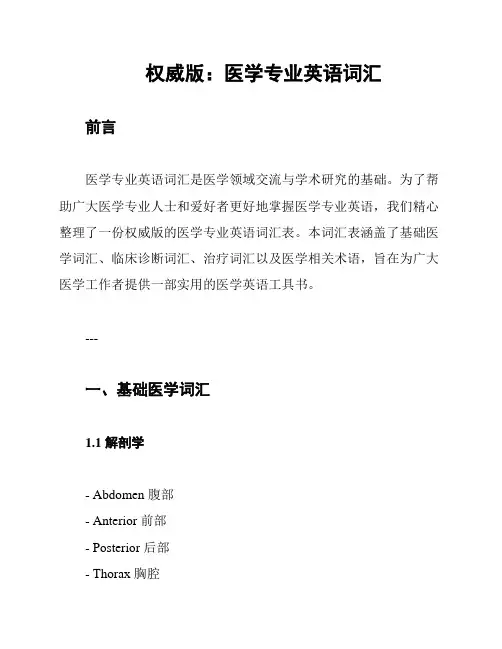
权威版:医学专业英语词汇前言医学专业英语词汇是医学领域交流与学术研究的基础。
为了帮助广大医学专业人士和爱好者更好地掌握医学专业英语,我们精心整理了一份权威版的医学专业英语词汇表。
本词汇表涵盖了基础医学词汇、临床诊断词汇、治疗词汇以及医学相关术语,旨在为广大医学工作者提供一部实用的医学英语工具书。
---一、基础医学词汇1.1 解剖学- Abdomen 腹部- Anterior 前部- Posterior 后部- Thorax 胸腔- Lungs 肺- Heart 心脏- Skull 颅骨- Brain 脑- Spine 脊柱- Vertebrae 椎骨- Hip 髋关节- Femur 股骨- Tibia 胫骨- Fibula 腓骨- Ankle 踝关节- Shoulder 肩关节- humerus 肱骨- Radius 桡骨- Ulna 尺骨- Wrist 手腕1.2 生理学- Respiration 呼吸- Circulation 循环- Digestion 消化- Metabolism 代谢- Nervous System 神经系统- Endocrine System 内分泌系统- Immune System 免疫系统- Reproduction 生殖- Urination 排尿- Excretion 排泄1.3 病理学- Cancer 癌症- Inflammation 炎症- Infection 感染- Allergy 过敏- Autoimmune Disease 自身免疫病- Genetic Disease 遗传病- Degenerative Disease 退行性疾病二、临床诊断词汇2.1 诊断方法- Physical Examination 体检- Laboratory Examination 实验室检查- Imaging Examination 影像学检查- Endoscopy 内镜检查- Biopsy 活检2.2 常见症状- Fever 发热- Pain 疼痛- Vomiting 呕吐- Diarrhea 腹泻- Fatigue 疲劳- Dizziness 头晕- Anxiety 焦虑- Depression 抑郁2.3 疾病名称- Diabetes Mellitus 糖尿病- Myocardial Infarction 心肌梗死- Cerebrovascular Accident 脑卒中-肺炎 Pneumonia- Arthritis 关节炎- Cancer 癌症- Asthma 哮喘- Ulcer 溃疡---三、治疗词汇3.1 治疗方法- Drug Therapy 药物治疗- Surgery 手术- Radiation Therapy 放射治疗- Chemotherapy 化疗- Immunotherapy 免疫治疗- Physical Therapy 物理治疗3.2 药物名称- Aspirin 阿司匹林- Penicillin 青霉素- Insulin 胰岛素- Glucocorticoid 糖皮质激素- Antibiotics 抗生素- Anesthetics 麻醉剂---四、医学相关术语- ECG 心电图- MRI 磁共振成像- CT 计算机断层扫描- Ultrasound 超声波- Dialysis 透析- Transplantation 移植- Angioplasty 血管成形术- Stent 支架---结语本词汇表旨在为广大医学工作者提供一部实用的医学英语工具书,以便更好地进行国际交流和学术研究。
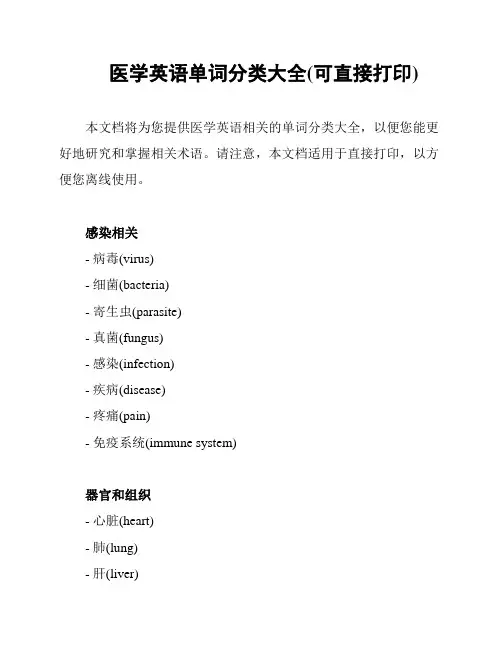
医学英语单词分类大全(可直接打印)本文档将为您提供医学英语相关的单词分类大全,以便您能更好地研究和掌握相关术语。
请注意,本文档适用于直接打印,以方便您离线使用。
感染相关- 病毒(virus)- 细菌(bacteria)- 寄生虫(parasite)- 真菌(fungus)- 感染(infection)- 疾病(disease)- 疼痛(pain)- 免疫系统(immune system)器官和组织- 心脏(heart)- 肺(lung)- 肝(liver)- 肾(kidney)- 脑(brain)- 肌肉(muscle)- 骨骼骨骼骨骼(bone)- 血液(blood)疾病和症状- 癌症(cancer)- 糖尿病(diabetes)- 高血压(hypertension)- 皮肤病(skin disease)- 呼吸困难(breathing difficulties) - 头痛(headache)- 咳嗽(cough)- 发热(fever)药物和治疗- 药物(medication)- 抗生素(antibiotics)- 镇痛药(painkillers)- 手术(operation)- 放疗(radiation therapy)- 化疗(chemotherapy)- 康复(Rehabilitation)生理和疾病科学- 分子生物学(molecular biology)- 遗传学(genetics)- 器官移植(organ transplantation)- 血压血压血压血压(blood pressure)- 血糖血糖血糖血糖(blood sugar)- 体温(体温温度温度温度temperature)- 风湿病(rheumatism)以上仅为部分分类,这份医学英语单词分类大全可帮助您扩充医学英语词汇量,希望对您有所帮助。
如果您需要更多的分类或者具体单词,请随时告知我。
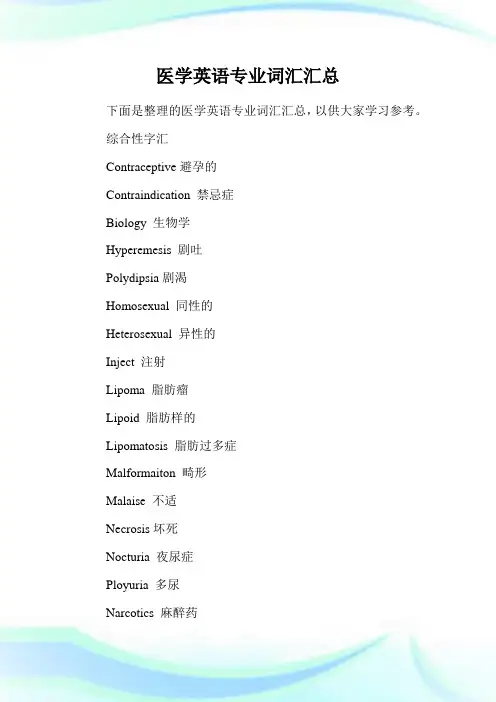
医学英语专业词汇汇总下面是整理的医学英语专业词汇汇总,以供大家学习参考。
综合性字汇Contraceptive避孕的Contraindication 禁忌症Biology 生物学Hyperemesis 剧吐Polydipsia剧渴Homosexual 同性的Heterosexual 异性的Inject 注射Lipoma 脂肪瘤Lipoid 脂肪样的Lipomatosis 脂肪过多症Malformaiton 畸形Malaise 不适Necrosis坏死Nocturia 夜尿症Ployuria 多尿Narcotics 麻醉药Hyperplasia 增殖Dysplasia 发育不良Dyspepsia 消化不良Prognosis 预後Antipyretic 解热剂Hydrophobia 恐水症Photophobia 畏光Antibiotic 抗生素Syndrome 症候群Hydrotherapy 水疗法Perforation 穿孔Percussion叩诊Visceralgia脏器痛二、妇产科常用字汇Genital 生殖的Gynecology 妇科Menstruation 月经Menopause 更年期Menorrhagia经血过多Amenorrhea 无月经Dysmenorrhea经痛Menarche初经Cervical cancer 子宫颈癌Cervical Erosion子宫颈糜烂Cervicitis子宫颈炎Perineum会阴Endometriosis子宫内膜异位Ovary 卵巢Ovarian Cyst 卵巢囊肿Ovulation排卵Vaginitis阴道炎Colposcopy 阴道镜检法Galactocele乳腺囊肿Mammography 乳房X光摄影术Infertility 不孕症InVitro Fertilization 体外受精Amnion 羊膜Amniocentesis 羊膜穿刺术Amniotic Fluid Embolism 羊水栓塞Hydramnion 羊水过多Anterpartal 产前的Antepartum 分娩前Chorionic Villi Sampling 绒毛膜绒毛取样Cephalo Pelvic Disproportion 胎头骨盆不对称Artificial Insemination 人工受精Engagement 进入产位Estrogen动情基素Colostrum 初乳Termination of Pregnancy 终止怀孕Corpus Luteum 黄体Vacuum Extraction Delivery 真空吸出分娩Venereal Disease 性病Tubal Ligation 输卵管结扎Laparoscope 腹腔镜Embryo 胚胎Ectopic Gestation 子宫外孕Primipara 初产妇Attitude of Fetus 胎儿体位Dead Detus in Uterus 胎死腹中Multipara 经产妇Parity 经产Placenta Previa前置胎盘Postpartum 产後Postpartum hemorrhage产後出血Toxemia of Pregnancy 妊娠毒血症Adolescence青春期Basal Body Temperature 基础体温Cesarean Section 剖腹产Expected Date of Confinement 预产期Fallopian Tube 输卵管Forceps 产钳incoherent 语无伦次thought Withdrawal 思想退缩irrelevant 答非所问delusion 妄想delusion of persecution 被害妄想delusion of grandeur 夸大妄想Phobia 恐惧症acrophobia 惧高症algophobia 惧痛症sexual drive 性欲illusion 错觉hallucination 幻觉auditory hallucination 听幻觉disoreinatation 失去定向力amnesia记忆丧失症confabulation 虚谈症orientation 定向力judgement 判断力derealization 失真感insight病识感no insight 无病识感intellectual insight 理性的病识感。
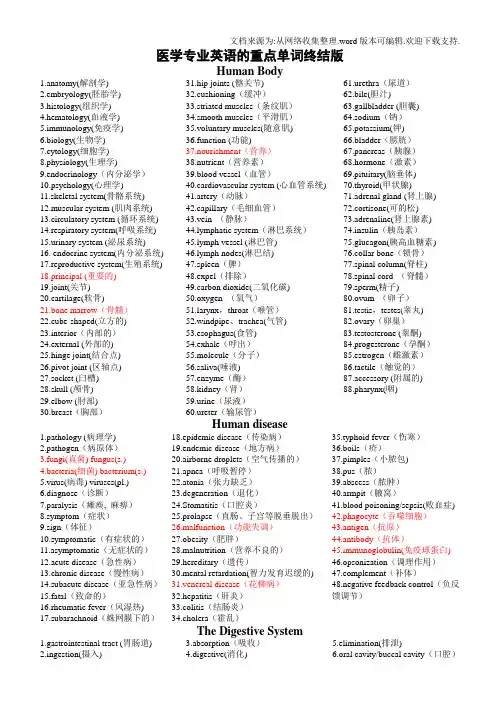
文档来源为:从网络收集整理.word版本可编辑.欢迎下载支持. 医学专业英语的重点单词终结版Human Body1.anatomy(解剖学)2.embryology(胚胎学)3.histology(组织学)4.hematology(血液学)5.immunology(免疫学)6.biology(生物学)7.cytology(细胞学)8.physiology(生理学)9.endocrinology(内分泌学)10.psychology(心理学)11.skeletal system(骨骼系统)12.muscular system (肌肉系统)13.circulatory system (循环系统)14.respiratory system(呼吸系统)15.urinary system (泌尿系统)16. endocrine system(内分泌系统)17.reproductive system(生殖系统)18.principal (重要的)19.joint(关节)20.cartilage(软骨)21.bone marrow(骨髓)22.cube-shaped(立方的)23.interior(内部的)24.external (外部的)25.hinge joint(结合点)26.pivot joint (区轴点)27.socket (臼槽)28.skull (颅骨)29.elbow (肘部)30.breast(胸部)31.hip joints (髂关节)32.cushioning(缓冲)33.striated muscles(条纹肌)34.smooth muscles(平滑肌)35.voluntary muscles(随意肌)36.function (功能)37.nourishment(营养)38.nutrient(营养素)39.blood vessel(血管)40.cardiovascular system (心血管系统)41.artery(动脉)42.capillary(毛细血管)43.vein (静脉)44.lymphatic system(淋巴系统)45.lymph vessel (淋巴管)46.lymph nodes(淋巴结)47.spleen(脾)48.expel(排除)49.carbon dioxide(二氧化碳)50.oxygen (氧气)rynx,throat(喉管)52.windpipe、trachea(气管)53.esophagus(食管)54.exhale(呼出)55.molecule(分子)56.saliva(唾液)57.enzyme(酶)58.kidney(肾)59.urine(尿液)60.ureter(输尿管)61.urethra(尿道)62.bile(胆汁)63.gallbladder (胆囊)64.sodium(钠)65.potassium(钾)66.bladder(膀胱)67.pancreas(胰腺)68.hormone(激素)69.pituitary(脑垂体)70.thyroid(甲状腺)71.adrenal gland (肾上腺)72.cortisone(可的松)73.adrenaline(肾上腺素)74.insulin(胰岛素)75.glucagon(胰高血糖素)76.collar bone(锁骨)77.spinal column(脊柱)78.spinal cord (脊髓)79.sperm(精子)80.ovum (卵子)81.testis,testes(睾丸)82.ovary(卵巢)83.testosterone (睾酮)84.progesterone(孕酮)85.estrogen(雌激素)86.tactile(触觉的)87.accessory (附属的)88.pharynx(咽)Human disease1.pathology (病理学)2.pathogen(病原体)3.fungi(真菌) fungus(s.)4.bacteria(细菌) bacterium(s.)5.virus(病毒) viruses(pl.)6.diagnose(诊断)7.paralysis(瘫痪, 麻痹)8.symptom(症状)9.sign(体征)10.symptomatic(有症状的)11.asymptomatic(无症状的)12.acute disease(急性病)13.chronic disease(慢性病)14.subacute disease(亚急性病)15.fatal(致命的)16.rheumatic fever(风湿热)17.subarachnoid(蛛网膜下的)18.epidemic disease(传染病)19.endemic disease(地方病)20.airborne droplets(空气传播的)21.apnea(呼吸暂停)22.atonia(张力缺乏)23.degeneration(退化)24.Stomatitis(口腔炎)25.prolapse(直肠、子宫等脱垂脱出)26.malfunction(功能失调)27.obesity(肥胖)28.malnutrition(营养不良的)29.hereditary(遗传)30.mental retardation(智力发育迟缓的)31.venereal disease(花柳病)32.hepatitis(肝炎)33.colitis(结肠炎)34.cholera(霍乱)35.typhoid fever(伤寒)36.boils(疥)37.pimples(小脓包)38.pus(脓)39.abscess(脓肿)40.armpit(腋窝)41.blood poisoning/sepsis(败血症)42.phagocyte(吞噬细胞)43.antigen(抗原)44.antibody(抗体)45.immunoglobulin(免疫球蛋白)46.opsonization(调理作用)plement(补体)48.negative feedback control(负反馈调节)The Digestive System1.gastrointestinal tract (胃肠道)2.ingestion(摄入)3.absorption(吸收)4.digestive(消化)5.elimination(排泄)6.oral cavity/buccal cavity(口腔)文档来源为:从网络收集整理.word版本可编辑.欢迎下载支持.7.palate(腭)8.chewing(mastication)(咀嚼)9.swallowing(deglutition)(吞咽)10.incisor(切牙)11.cuspid(尖牙)canine(犬牙)12.molar(磨牙)13.cementum(牙骨质)14..gum(牙龈)15..gingiva(牙龈)16.pulp(牙髓)17.enamel(牙釉质)18.periodontium(牙周组织)19.deciduous dentiton(乳牙)20.permanent dentition (恒牙)21.lower jaw bone(下颌骨)22.papillae(乳头)23.taste bud(味蕾)24.uvula(悬雍垂)25.parotid gland(腮腺)26.submandibular gland(下颌下腺) 27sublingual gland (舌下腺)28.epiglottis(会厌)29.nasal cavity(鼻腔)30.peristalsis(蠕动)31.fundus(胃底)32.antrum(胃窦)33.cardiac sphincter(贲门括约肌)34.pyloric sphincter(幽门括约肌)35.chyme(食糜)36.duodenum(十二指肠)37.jejunum(空肠)38.ileum(回肠)39.cecum(盲肠)40.rectum(直肠)41.colon(结肠)42.sigmoid colon (乙状结肠)43.ileocecal valve (回盲瓣)44.ascending colon (升结肠)45.transverse colon (横结肠)46.descending colon (降结肠)47.appendix(阑尾)48.stool/feces(粪便)49.anus(肛门)50. hydrochloric acid (盐酸)51.abdomen(腹部)52.cholesterol(胆固醇)53.bile pigment(胆色素)54.bilirubin(胆红素)55.blood protein(血红蛋白)56.erythrocyte(红细胞)57.glycogen(糖原)58.cilia、villi(绒毛)59.amylase(淀粉酶)60.lipase(脂肪酶)61.hepatic duct(肝管)62.cystic duct(胆囊管)mon bile duct(胆总管)64.detoxification(解毒)65.emulsification (乳化作用)66.bile acid (胆酸)The Disorders of the Digestive System1.gingivitis (牙龈炎)2.peptic ulcer (消化性溃疡)3.vomiting(呕吐)4.perforation(穿孔)5.barium(钡)6.hiatal(裂孔的)7.hernia(疝)8.endoscopy (内窥镜检查)9.hemorrhage(出血)10.histamine (组胺)11.chest cavity (胸腔)12.diaphragm(膈)13.gastritis(胃炎)14.hepatitis(肝炎)15.cirrhosis(肝硬化)16.hepatomegaly(肝肿大)17.edema(浮肿)18.jaundice(黄疸) 19.architecture(结构)20.nodule(结节)21.micronodular(小结节)22.macronodular(巨结节)23.lobular(小叶的)24.cholelithiasis(胆结石)25.cholecystitis(胆囊炎)26.biliary colic(胆绞痛)27.nausea (恶心)28.cholecystectomy(胆囊切除术)paroscope(腹腔镜)30.pancreatitis(胰腺炎)31.paralytic ileus(麻痹性肠梗阻)32.autodigestion(自体消化)33.necrosis(坏死)34.epigastric(腹上部的)35.appendicitis(阑尾炎)36.navel(脐)37.peritonitis(腹腔炎)38.ulcerative colitis(溃烂性结肠炎)39.antibiotic(抗生素)40.fistula(瘘)41.diverticulum(憩室)42.diverticulitis(憩室炎)43.diverticulosis(憩室病)44.polyps(息肉)45.diarrhea(腹泻)46.occult blood(隐血)47.proctoscope(直肠镜)48.sigmoidoscope(乙状结肠镜)49.colonoscope(结肠镜)50.ileostomy(回肠造口术)51.colostomy(结肠造口术)52.gastroduodenostomy(胃十二指肠吻合术)53.coloproctostomy(结肠直肠吻合术)Respiratory System1.pulmonary veins(肺静脉)2.irritant(刺激物)3.frontal sinus(额窦)4.ethmoidal sinus(刷窦)5.sphenoid sinus(蝶窦)6.maxillary sinus (上颌窦)7.paranasal sinus(副鼻窦)8.nasal cavity(鼻腔)9.nostril(鼻孔)10.nasopharynx (鼻咽)11.oropharynx(口咽)12.hypopharynx(下咽)ryngopharynx(喉咽)14.adenoids(腺体肿大)15.hypopharyngeal(下咽的)16.pharyngeal tonsils(咽扁桃体)17. palatine tonsils(腭扁桃体)18.tongue tonsil(舌扁桃体)19.vocal cords(声带)20.mucous membrane(分泌粘液的膜)21.fibrous connective tissue(纤维结缔组织)22.bronchi(支气管)23.Bronchiole(细支气管)24.alveoli,alveolus(肺泡)25.epithelium(上皮)26.parietal pleura(壁层胸膜)27.visceral pleura(脏层胸膜)28.horizontal fissure(水平裂)29.oblique fissure(斜裂)30.apex(肺尖)31.hilum(肺门)32.Collarbone(锁骨)33.diaphragm(横膈)34.mediastinum(纵隔)35.thoracic cavity (胸腔)36.abdominal cavity(腹腔)37.inhalation/inspiration(吸气)38.exhalation/expiration(呼气)39.brainstem(脑干)40.phrenic nerve(膈神经)41.acid(酸)42.acidity(酸度)文档来源为:从网络收集整理.word版本可编辑.欢迎下载支持.43.acidosis(酸中毒)44.alkalinity(碱度)45.alkali(碱)46.alkalosis(碱中毒)47.hyperventilation (换气过度)48.hypoventilation(换气不足)49..macrophages(巨噬细胞)50.mucus(粘液)Respiratory Disorders and Diseases1.pneumonia(肺炎)2.tuberculosis(结核)3.asthma (哮喘)4.allergic(过敏的)5.emphysema(肺气肿)6.influenza(流行性感冒)7.pneumonitis(肺炎)8.lobar pneumonia(大叶性肺炎)9.bronchopneumonia(支气管肺炎)10.pleurisy(胸膜炎)11.tubercle(结核结节)12.hemoptysis(咯血)13.phlegm(痰)14.exudates(渗出物)15.solidification(固化) 16.consolidation(实变)17.dyspnea(呼吸困难)18.cyanosis(紫绀)19.wheeze(喘息)20.Steroids(类固醇)21.allergen(过敏原)22.polio(脊髓灰质炎,小儿麻痹症)23.paralyze(瘫痪)24.mature(成熟的)25.prematurely(过早地, 早熟地)26.digitalis(洋地黄)27.diuretics(利尿剂)28.atrium(心房)29. acute pulmonary edema(急性肺水肿)30.pneumothorax(气胸)31.pneumoconiosis(尘肺)32.silicosis(矽肺)33.anthracosilicosis(碳矽末沉着症)34.bronchitis(支气管炎)35.bronchiectasis(支气管扩张)36.bronchospasm(支气管痉挛)37.hypercapnia(高碳酸血症)38.simple chronic bronchitis(单纯性慢性支气管炎).39.chronic obstructive bronchitis(慢性梗阻性支气管炎)40.asthmatic bronchitis(哮喘性支气管炎)41.noxious(有害的,有毒的)Common disorders of the cardiovascular1.atherosclerosis(动脉粥样硬化)2.lumen(内腔)3.ischemia(局部缺血)4.coronary heart disease(冠心病)5.angina pectoris(心绞痛)6.clot(血凝块)7.thrombosis(血栓形成)8.thrombus(血栓)9.myocardial infarction(心肌梗死)10.arhythmia(心律不齐)11.fibrillation(纤维性颤动)12.embolism(栓塞)13.embolus(栓子)14.stroke(中风)15.subcutaneous(皮下的)16.syncope(晕厥) 17.glomerulonephritis(肾小球肾炎)18.pyelonephritis(肾盂肾炎)19.rheumatic heart disease(风湿性心脏病)20.valvular murmur(瓣膜杂音)21.systolic pressure(收缩压)22.diastolic pressure(舒张压)23.congestive heart failure (充血性心力衰竭)24.vegetation (赘生物)25.essential hypertension(原发性高血压)26.secondary hypertension(继发性高血压)27.endocarditis(心内膜炎)28.pericardial tamponade(心包填塞)29.pericarditis(心包炎)30.hemorrhage(出血)31.shock(休克)32.plasma(血浆)33.dextran(右旋糖酐)34.vomitus(呕吐物)35.spermatic cord (精索)36.ligament(韧带)37.uterus(子宫)38.piles,hemorrhoid(痔疮)39.varix,varices(静脉曲张)40.phlebitis(静脉炎)41.etiology(病因学)42.dextran(右旋糖酐)Blood and immunity1.hemocyte(血细胞)2.erythrocyte(红细胞)3.leukocyte(白细胞)4.platelets(血小板)5.thrombocytes(血小板)6.clotting cells(血小板)7.plasma(血浆)8.fibrinogen(纤维蛋白原)9.fibrin(纤维蛋白)10.albumin(白蛋白)11.globulin(球蛋白)12.prothrombin(纤维蛋白原)13.globin(珠蛋白)14.hemoglobin(血红球蛋白)15.pigment(色素)16.heme(亚铁血红素)17.electrolyte(电解质)18.clotting factors(凝血因子)19.nucleus(核) nuclei(pl.)20.erythropoietin(促红细胞生成素)21.granulocytes(粒细胞)22.eosinophil(嗜酸性粒细胞)23.basophil(嗜碱性粒细胞)24.neutrophil(嗜中性粒细胞)25.agranulocyte(无粒细胞)26.monocyte(单核细胞)27.lymphocyte(淋巴细胞)28.polymorphonuclear(多形核细胞)29. detoxify(解毒作用)30.heparin(肝素)31.phagocytic (吞噬细胞的)32.macrophages(巨噬细胞)33.phagocyte(吞噬细胞)34.phagocytosis(吞噬作用)35.megakaryocyte(巨核细胞)36.hemostasis(止血)37.immunoglobulin(免疫球蛋白)38.thymus gland(胸腺)39.lymphoid organs(淋巴器官)40.debris(残片)41.cytotoxic(细胞毒性)42.interferons(干扰素)43.interleukins(白细胞介素)44.anemia(贫血)45.fatigue(乏力)46.heart palpitation(心悸)47.pallor(面色苍白)48.irritation(烦躁不安)49.aplastic anemia(再生障碍性贫血)50.pancytopenia(全细胞减少)51.hemolytic anemia (溶血性贫血)52.spherocytosis(球形红细胞增多症)53.jaundice(黄疸)54.pernicious(恶性贫血)55.megaloblast(巨成红细胞)56.sickle cell anemia(镰刀细胞性贫血)57.arthralgias(关节痛)58.extremities(四肢)59.ulceration(溃疡)60.thalassemia(地中海贫血)61.thrombocytopenia(血小板减少症)62.petechiae(瘀点)63.ecchymosis(瘀斑) 64.purpura(紫癜)65.hemophilia(血友病)66.intramuscular(肌肉下的)67.autoimmune disease(自身免疫性疾病)68.hematuria(血尿)69.hemarthrosis(关节积血)70.leukemia(白血病)71.neoplasms(肿瘤)72.acute myelogenous leukemia(急粒)73.acute lymphocytic leukemia (急淋)74.chronic myelogenous leukemia(慢粒)75.chronic lymphocytic leukemia(慢淋)76.multiple myeloma(骨髓瘤)77.plasma cells (浆细胞)78.osteolytic(溶骨性的)79.myeloblast(成髓细胞,原粒细胞)80.lymphoblast(成淋巴细胞)81.hypercalcemia(高钙血症)82.itching(痒)83.rash(皮疹)84.sneezing(喷嚏)85.urticaria(荨麻疹)86.asthma(哮喘)87.immunodeficiency(免疫缺陷)88.dysgammaglobulinemia(异常γ球蛋白血症)89.extrinsic(外缘的)90.intrinsic(内源性的)91.lymphadenopathy (淋巴结病) Development & Genetics1.zygote(合子)2.oviduct(输卵管)3.endometrium(子宫内膜)4.embryo(胚胎)5.chorionic sac(绒毛囊)6.chorion(绒毛膜)7.gonadotropin(促性腺激素)8.corpus luteum(黄体)9.placenta(胎盘)10.amniotic sac(羊膜囊)11.amniorrhea(破水)12.trimester(三个月,三月期)13.parturition(分娩)14.dystocia (难产)15.cesarean birth(剖宫产)16.oxytocin(催产素)17.prostaglandin (前列腺素)18. meiosis(减数分裂,成熟分裂)19.mitosis(有丝分裂)20.triplet(三胞胎)21.quadruplet(四胞胎)22.dissimilar(不同的)23.abort(流产)24.vagina(阴道)25.cervix(子宫颈)26.fallopian tubes(输卵管)27.fertilization(受孕,受精)28.pregnancy tests(妊娠试验)29.fetus(胎儿)30.umbilical cord(脐带)31.amnion(羊膜囊)32.menstrual(月经)33.birth canal(产道)34.gravida(孕次)35.primigravida(初孕妇)36.para(产次)37.inheritable(可遗传的)38.offspring(后代)39.dominant(显性)40.recessive(隐性)41.cell division(细胞分裂)42.rearrangement(重排)43.fragment(碎片)44.dissimilar(不同)45.identical(相同)Disorders of Pregnancy & Genetic Disease1.preeclampsia/eclampsia(先兆子痫)2.toxemia(毒血症)3.proteinuria(蛋白尿)4.ectopic(异位的)5.salpingitis(输卵管炎)6.endometriosis(子宫内膜异位症)paroscopic(腹腔镜检查的)8.miscarriage(自然流产)9.incompetence(无能力)10.induced abortion (人工流产)11.suction(抽吸)12.birth defect(先天缺陷)13.teratogen(致胎儿畸形药)14.malformation(畸形;变形)15.rubella/german measles(风疹) 16.measles(麻疹)17.herpes simplex(单纯疱疹)18.syphilis(梅毒)19.atresia(闭锁畸形)20.anencephalus(无脑畸形)21.spina bifida(脊柱裂)22.cleft lip(唇裂)23.cleft palate(腭裂)24.diabetes mellitus(糖尿病)25.amniocentesis(羊膜穿刺术)26.karyotype(染色体组型)27.chorionic villus(绒膜绒毛)28.transmit(传递)29.Mendelian fashion(孟德尔遗传定律)30.immunogenetics(免疫遗传学)31.incur(招致)32.mutagen(诱变剂,诱变因素)33.mutagenic(诱变的)34.carcinogen(致癌物)35.albinism(白化病)36.pigmentation(色素沉着)37.homozygote(纯合子)38.progeny(后裔,后代)39.schizophrenia(精神分裂症)40.counselor(咨询者;顾问)41.mutant(突变型;变异的)42.prenatal(出生前的)43.lethal(致命的)44.euphenics(优型学)45.euphenic(优型学的)Endocrine System1.endocrine(内分泌)2.dwarf(矮小症)3.hormone(激素)4.gland(腺体)5.glandular(腺体的)6.reproduction(生殖)7.metabolism(代谢)8.nutrien(营养素)9.target tissue(靶组织)10.receptor(受体)11.hormonal(激素的)12.steroid(类固醇)13.lipid(脂质)14.protein(蛋白)15.proteinlike compound(类似蛋白质的化合物)16.gonad(性腺)17.cortex(皮质,皮层)18.adrenal gland (肾上腺)19.kidney(肾脏)20.renin(肾素)21.calcium(钙)22.phosphorus(磷)23.pituitary(脑垂体)24.thyroid(甲状腺)25.parathyroid(甲状旁腺)26.pancreas(胰)27.pineal(松果体)28.sphenoid(蝶骨)29.anterior lobe(前叶)30.adenohypophysis(腺垂体)31.posterior lobe(后叶)32. neurohypophysis(神经垂体)33.hypothalamus(下丘脑)34.mammary(乳房的)35.antidiuretic(抗利尿的)36.oxytocin(催产素)37.uterine(子宫的)38.isthmus(峡)39.thyroxine(T4)40.triiodothyronine(T3)41.calcitonin(降钙素)42.homeostasis(内稳态)43.medullar(髓的)44.corticosteroid(皮质类固醇)45.glucocorticoid(糖皮质激素)46.cortisol(可的松)47.mineralocorticoid(盐皮质激素)48.aldosterone(醛固酮)49.epinephrine(肾上腺素)50.norepinephrine,noradrenaline(去甲肾上腺素)51.abdomen(腹部)52.exocrine(外分泌的)53.islets of Langerhans(胰岛)54.ovarian(卵巢的)55.estradiol(雌二醇)56.progesterone(孕酮)57.pregnancy(怀孕)58.malatonin(褪黑素)59.puberty(青春期)60.circadian rhythms(昼夜节律)61. Parathyroid hormone(PTH)62. calcitonin(降血钙素)63.Cushing's syndrome(库欣综合症)64.primary aldosteronism(原发性醛固酮增多症)65.pheochromocytoma(嗜铬细胞瘤)66.gigantism(巨人症)67.acromegaly(肢端肥大症)68.diabetes insipidus(尿崩症)69.hyperthyroidism(甲状腺功能亢进症)70.Graves'disease71.hyperparathyroidism(甲状旁腺功能亢进)72.hypoparathyroidism(甲状旁腺功能低下)73.hyperglycemia(高血糖)74.Addison's disease75.diabetes mellitus(糖尿病)76.glucose(葡萄糖)77.ketoacidosis(酮酸中毒)78.endemic goiter(地方性甲状腺肿大)79.nodular goiter(结节性甲状腺肿大)80.myxedema(粘液性水肿)81.bruit(杂音)82.ptosis(上睑下垂)The Nervous System1.neuron(神经元)2.neurology(神经病学)3.acetylcholine(乙酰胆碱)4.efferent(传出神经)5.afferent(传入神经)6.parasympathetic(副交感神经)7.sympathetic(交感神经)8.ganglion(神经节)9.plexus(神经丛)10.dendrite(树突)11.electrical charge(电信号)12.axon(轴突)13.myelin(髓鞘)14.neurilemma(神经鞘)15.synapse(突触)16.white matter(白质)17.gray matter(灰质)18.neurotransmitter(神经递质)19.neuroglia(神经胶质)20.astrocyte(星型胶质细胞)21.glioma(神经胶质瘤)22.microglia(小神经胶质细胞)23.oligodendroglia(少突胶质细胞)24.cerebrum(大脑)25.convolution,gyrus(脑回)26.peripheral nervous system(周围神经系统)27.autonomic nervous system(自主神经系统)28.visceral nervous system(内脏神经系统)29.groove(沟)30.fissure(裂)31.sulcus(沟)32.thalamus(丘脑)33.hypothalamus(下丘脑)34.diencephalon(间脑)35.pons(脑桥)36.cerebellum(小脑)37.brain stem(脑干)38.medulla oblongata(延髓)39.meninx(脑膜)40.cauda epuina (马尾)41.dura(硬脑膜)42.mater(脑脊髓膜)43.arachnoid(脑蛛网膜)44.pia mater(软脑脊膜)45.lumbar puncture(腰椎穿刺术)08级临床专英卷子(蔡江瑜整理)Tips:介于市面上缺少专英真题,这是我根据记忆整理的,漏了几个单词,段落翻译只能记得些关键词,不过应该翻翻书还是能找到的,给大家一些参考。
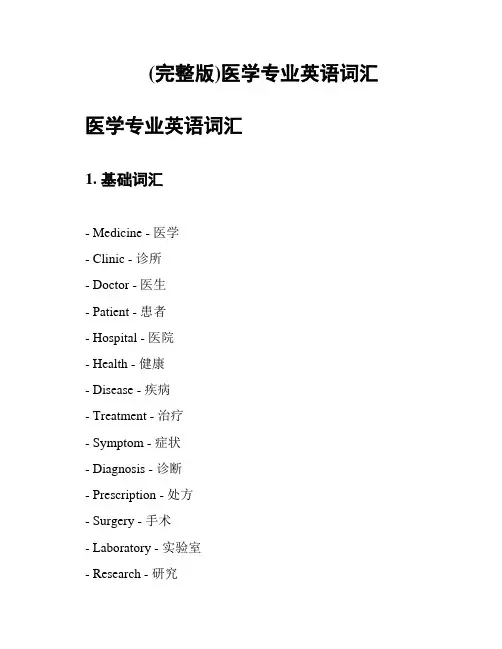
(完整版)医学专业英语词汇医学专业英语词汇1. 基础词汇- Medicine - 医学- Clinic - 诊所- Doctor - 医生- Patient - 患者- Hospital - 医院- Health - 健康- Disease - 疾病- Treatment - 治疗- Symptom - 症状- Diagnosis - 诊断- Prescription - 处方- Surgery - 手术- Laboratory - 实验室- Research - 研究- University - 大学- Medical - 医疗的- Nurse - 护士- Pharmacist - 药剂师- Therapist - 治疗师- Vaccine - 疫苗- X-ray - X光片- HIV - 人类免疫缺陷病毒- Cancer - 癌症- Diabetes - 糖尿病- Heart - 心脏- Kidney - 肾脏- Liver - 肝脏2. 解剖学词汇- Anatomy - 解剖学- Skeleton - 骨骼- Muscle - 肌肉- Nervous system - 神经系统- Digestive system - 消化系统- Respiratory system - 呼吸系统- Circulatory system - 循环系统- Skeletal system - 骨骼系统- Muscular system - 肌肉系统- Nervous tissue - 神经组织- Respiratory tract - 呼吸道- Circulatory system - 循环系统- Digestive tract - 消化道- Central nervous system - 中枢神经系统- Peripheral nervous system - 外周神经系统- Endocrine system - 内分泌系统- Urinary system - 泌尿系统3. 疾病词汇- Infection - 感染- Allergy - 过敏- Fever - 发烧- Inflammation - 炎症- Pain - 疼痛- Cough - 咳嗽- Headache - 头痛- Fatigue - 疲劳- Depression - 抑郁症- High blood pressure - 高血压- Arthritis - 关节炎- Asthma - 哮喘- Alzheimer's disease - 阿尔茨海默病- Stroke - 中风- Multiple sclerosis - 多发性硬化症- Pneumonia - 肺炎- Cancer - 癌症- Diabetes - 糖尿病- Heart disease - 心脏病- Kidney disease - 肾脏疾病- Liver disease - 肝脏疾病- Sexually transmitted disease - 性传播疾病4. 检查和测试词汇- Blood test - 血液检查- Urine test - 尿液检查- X-ray - X光检查- Ultrasound - 超声波- MRI (Magnetic Resonance Imaging) - 磁共振成像- ECG (Electrocardiogram) - 心电图- PET scan (Positron Emission Tomography) - 正电子发射断层扫描- Colonoscopy - 结肠镜检查- Pap smear - 涂片检查- Biopsy - 活检- Lymph node biopsy - 淋巴结活检- Bone marrow biopsy - 骨髓活检5. 药物相关词汇- Medication - 药物- Drug - 药品- Prescription - 处方药- Over-the-counter (OTC) - 非处方药- Antibiotics - 抗生素- Analgesics - 镇痛药- Antidepressants - 抗抑郁药- Antipyretics - 退热药- Antihistamines - 抗组织胺药- Anticoagulants - 抗凝药- Opioids - 麻醉药- Diuretics - 利尿药- Antivirals - 抗病毒药- Anti-inflammatory - 抗炎药- Beta blockers - 贝塔受体阻滞剂- Statins - 他汀类药物- Vaccines - 疫苗- Insulin - 胰岛素- Cholesterol-lowering drugs - 降低胆固醇药物以上是医学专业英语词汇的一部分,希望对您的学习和工作有所帮助。
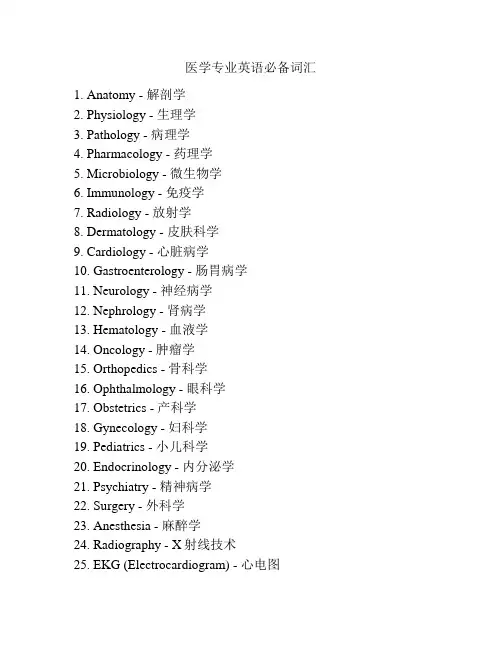
医学专业英语必备词汇1. Anatomy - 解剖学2. Physiology - 生理学3. Pathology - 病理学4. Pharmacology - 药理学5. Microbiology - 微生物学6. Immunology - 免疫学7. Radiology - 放射学8. Dermatology - 皮肤科学9. Cardiology - 心脏病学10. Gastroenterology - 肠胃病学11. Neurology - 神经病学12. Nephrology - 肾病学13. Hematology - 血液学14. Oncology - 肿瘤学15. Orthopedics - 骨科学16. Ophthalmology - 眼科学17. Obstetrics - 产科学18. Gynecology - 妇科学19. Pediatrics - 小儿科学20. Endocrinology - 内分泌学21. Psychiatry - 精神病学22. Surgery - 外科学23. Anesthesia - 麻醉学24. Radiography - X射线技术25. EKG (Electrocardiogram) - 心电图26. CT Scan (Computerized Tomography) - 计算机断层扫描27. MRI (Magnetic Resonance Imaging) - 磁共振成像28. Ultrasound - 超声波29. Biopsy - 活检30. Diagnosis - 诊断31. Treatment - 治疗32. Prescription - 处方33. Medication - 药物34. Surgery - 手术35. Vaccine - 疫苗36. Epidemic - 流行病37. Pandemic - 大流行病38. Symptom - 症状39. Infection - 感染40. Contagious - 传染性的41. Immunity - 免疫力42. Antibiotic - 抗生素43. Antiviral - 抗病毒药物44. Antiseptic - 杀菌剂45. Anesthesia - 麻醉46. Sterilization - 灭菌47. Rehabilitation - 康复48. Prognosis - 预后49. Chronic - 慢性的50. Acute - 急性的。
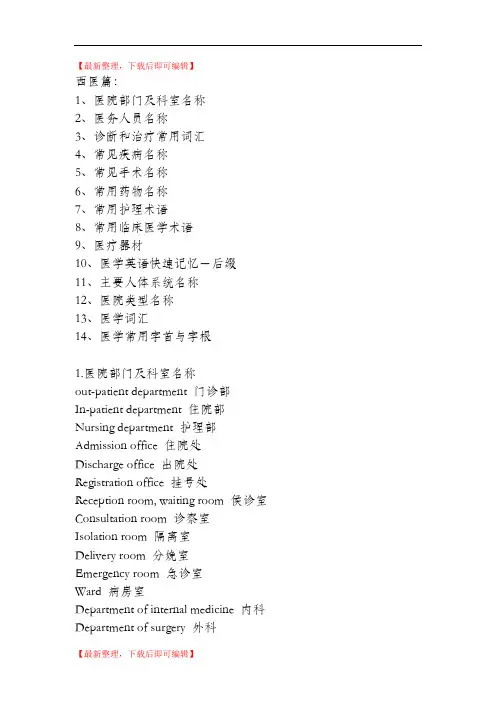
【最新整理,下载后即可编辑】西医篇:1、医院部门及科室名称2、医务人员名称3、诊断和治疗常用词汇4、常见疾病名称5、常见手术名称6、常用药物名称7、常用护理术语8、常用临床医学术语9、医疗器材10、医学英语快速记忆-后缀11、主要人体系统名称12、医院类型名称13、医学词汇14、医学常用字首与字根1.医院部门及科室名称out-patient department 门诊部In-patient department 住院部Nursing department 护理部Admission office 住院处Discharge office 出院处Registration office 挂号处Reception room, waiting room 侯诊室Consultation room 诊察室Isolation room 隔离室Delivery room 分娩室Emergency room 急诊室Ward 病房室Department of internal medicine 内科Department of surgery 外科Department of pediatrics 儿科Department of obstetrics and gynecology 妇科Department of neurology 神经科Department of ophtalmology 眼科E.N.T.department 耳鼻喉科Department of stomatology 口腔科Department of urology 泌尿科Department of orthopedic 骨科Department of traumatology 创伤科Department of endocrinology 内分泌科Department of anesthesiology 麻醉科Department of dermatology 皮肤科Department of infectious diseases 传染病科Department of pathology 病理科Department of psychiatry 精神科Department of orthopacdic surgery 矫形外科Department of cardiac surgery 心脏外科Department of cerebral surgery 脑外科Department of thoracic surgery 胸外科Pharmacy dispensary 药房Nutrition department 营养部Diet-preparation department 配膳室Therapeutic department 治疗室Operating room/Theater 手术室Blood-bank 血站Supply-room 供应室Disinfection-room 消毒室Dressing room 换药室Mortuary 太平间Record room 病案室Department of plastic surgery 矫形外科Department of physiotherapy 理疗科electrotherapy room 电疗科heliotherapy room 光疗科wax-therapy room 蜡疗科hydrotherapy room 水疗科central laboratory 中心实验室clinical laboratory 临床实验室bacteriological laboratory 细菌实验室biochemical laboratory 生化实验室serological laboratory 血清实验室X-ray room X光室doctor’s office 医生办公室nurse’s office 护士办公室2.医务人员名称director of the hospital 院长physician 内科医师chief physician 主任医师associate chief physician 副主任医师attending doctor 主治医师resident doctor 住院医师intern doctor 实习医师general practitioner 全科医师specialist 专科医师head of the nursing department 护理部主任Head nurse 护士长Student nurse 实习护士E.N.T.doctor 耳鼻喉科医师Ophthalmologist 眼科医师Dentist 牙科医师Orthopedist 骨科医师Dermatologist 皮肤科医师urologist surgeon 泌尿外科医师neurosurgeon 神经外科医师plastic surgeon 矫形外科医师anaesthetist 麻醉科医师Doctor for tuberculosis 结核科医师Physiotherapist 理疗科Doctor for infectious diseases 传染病科Dietician 营养科医师Pediatrician 儿科医师Obstetrician 产科医师Midwife 助产师Gynecologist 妇科医师Radiologist 放射科医师Epidemiologist 流行病医师Pharmacist 药剂医师Assistant pharmacist 药剂医士Laboratory technician 化验员Assistant nurse 卫生员Cleaner 清洁员Controller 总务科长Registrar 挂号员Sanitation worker 消毒员3.诊断和治疗常用词汇inspection 望诊inquiry 问诊auscultation 听诊percussion 扣诊palpation 触诊biopsy 活组织检查pathological section 病理切片endoscopy 内窥镜检查ECG(electrocardiogram) examination 心电图检查EEG(electrocardiogram) examination 脑电图检查Intravenous pyelography 静脉肾盂造影术Skin-test 皮肤试验examination by centesis 穿刺检查routine analysis of blood 血常规分析urine analysis of blood 尿常规分析red blood cell count(RBC) 红细胞计数white blood cell count(WBC) 白细胞计数general check-up 全身检查routine examination 常规检查follow-up examination 随访检查consultation 会诊emergency 急诊diagnosis 诊断prognosis 预后convalescence, recovery 康复relapse 复发treatment 治疗prescribe 开药方fill a prescription 配药injecting 打针hypodermic injection 皮下注射intramuscular injection 肌肉注射intravenous injection 静脉注射inoculating 预防注射fluid infusion 点滴注射blood transfusion 输血dose 剂量tablet 药片capsule 胶囊liquid medicine 药水powder 药粉ointment 药膏(软膏)plaster 硬膏,石膏lotion 洗剂suppository 栓剂analgesics 止痛药antipyetics 退烧药antitussive 止咳药expectorant 祛痰药diuretics 利尿药hemostatic 止血药antidiarrheal 止泄药antipruritic 止痒药antidote 解毒药antirheumatic 抗风湿药anticarcinogen 抗癌药antibiotics 抗菌素anticoagulant 抗凝剂cardiac tonic 强心药vasodilator 血管舒张药vasoconstrictor 血管收缩药antiepileptic 抗癫痫药antispasmodic 解痉药sedative 镇静药anesthetics 麻醉药penicillin 盘尼西林streptomycin 链霉素gentamycin 庆大霉素aspirin 阿斯匹林morphine 吗啡dolantin 杜冷丁iodine 碘酒distilled water 蒸馏水normal saline solution 生理食盐水atropine 阿托品hormone 激素glucose 葡萄糖side effect, adverse effect 副作用operative treatment 手术疗法major operation 大手术minor operation 小手术anesthesia 麻醉general anesthesia 全身麻醉local anesthesia 局部麻醉excision, removal, resection 切除术tonsillectomy 扁桃体切除术thyroidectomy 甲状腺切除术pneumonectomy 肺切除术mastectomy 乳房切除术gastrectomy 胃切除术cholecystectomy 胆囊切除术hepalobectomy 肝叶切除术splenectomy 脾切除术nephrectomy 肾切除术salpingectomy 输卵管切除术hysterectomy 子宫切除术hysteromyomectomy 子宫肌瘤切除术proctectomy 直肠切除术appendectomy 阑尾切除术prostatectomy 前列腺切除术tracheotomy 气管切开术incision of abscess 脓肿切开术craniotomy 颅骨切开thoracotomy 胸廓切开laparotomy 剖腹术amputation 截肢fixation 固定hot compress 热敷cold compress 冷敷gastric lavage 洗胃enema 灌肠urethral catheterication 导尿hemostasis 止血dressing 包扎sew up the incision 缝合切口remove the stitches 拆线cardiac massage 心脏按摩artificial respiration 人工呼吸diet 饮食special diet 特定饮食low protein diet 低蛋白饮食low fat diet 低脂肪饮食low calorie diet 低热量饮食liquid diet 流质饮食semi-liquid diet 半流质饮食solid diet 固体饮食light diet 易消化的饮食vegetable diet 素食4.常见疾病名称Internal Medicine 内科Acidosis 酸中毒Adams-Stokes syndrome 亚-斯氏综合症alcoholism, alcoholic intoxication 酒精中毒alkalosis 碱中毒anaphylaxis 过敏症anemia 贫血iron deficiency anemia 缺铁性贫血megaloblastic anemia 巨幼红细胞性贫血aplastic anemia 再生障碍性贫血angiitis 脉管炎angina pectoris 心绞痛arteriosclerosis 动脉硬化apoplexy 中风auricular fibrillation 心房纤颤auriculo-ventricular block 房室传导阻滞bronchial asthma 支气管哮喘bronchitis 支气管炎bronchiectasis 支气管扩张bronchopneumonia 支气管肺炎carcinoma 癌cardiac arrhythmia 心律紊乱cardiac failure 心力衰竭cardiomyopathy 心肌病cirrhosis 肝硬化coronary arteriosclerotic heart disease 冠状动脉硬化性心脏病Crohn disease 克罗恩病Cushing’s syndrome 库欣综合症diabetes 糖尿病diffuse intravascular coagulation 弥散性血管凝血dysentery 痢疾enteritis 肠炎gastric ulcer 胃溃疡gastritis 胃炎gout 痛风hepatitis 肝炎Hodgkin’s disease 霍奇金病hyperlipemia 高脂血症,血脂过多hyperparathyroidism 甲状旁腺功能亢进hypersplenism 脾功能亢进hypertension 高血压hyperthyroidism 甲状腺功能亢进hypoglycemia 低血糖hypothyroidism 甲状腺功能减退infective endocarditis 感染性心内膜炎influenza 流感leukemia 白血病lobar pneumonia 大叶性肺炎lymphadenitis 淋巴结炎lymphoma 淋巴瘤malaria 疟疾malnutrition 营养不良measles 麻疹myeloma 骨髓瘤myocardial infarction 心肌梗死myocarditis 心肌炎nephritis 肾炎nephritic syndrome 肾综合症obstructive pulmonary emphysema 阻塞性肺气肿pancreatitis 胰腺炎peptic ulcer 消化性溃疡peritonitis 腹膜炎pleuritis 胸膜炎pneumonia 肺炎pneumothorax 气胸purpura 紫癜allergic purpura 过敏性紫癜thrombocytolytic purpura 血小板减少性紫癜pyelonephritis 肾盂肾炎renal failure 肾功能衰竭rheumatic fever 风湿病rheumatoid arthritis 类风湿性关节炎scarlet fever 猩红热septicemia 败血症syphilis 梅毒tachycardia 心动过速tumour 肿瘤typhoid 伤寒ulcerative colitis 溃疡性结肠炎upper gastrointestinal hemorrhage 上消化道血Neurology 神经科brain abscess 脑脓肿cerebral embolism 脑栓塞cerebral infarction 脑梗死cerebral thrombosis 脑血栓cerebral hemorrhage 脑出血concussion of brain 脑震荡craniocerebral injury 颅脑损伤epilepsy 癫痫intracranial tumour 颅内肿瘤intracranial hematoma 颅内血肿meningitis 脑膜炎migraine 偏头痛neurasthenia 神经衰弱neurosis 神经官能症paranoid psychosis 偏执性精神病Parkinson’s disease 帕金森综合症psychosis 精神病schizophrenia 精神分裂症Surgery 外科abdominal external hernia 腹外疝acute diffuse peritonitis 急性弥漫性腹膜炎acute mastitis 急性乳腺炎acute pancreatitis 急性胰腺炎acute perforation of gastro-duodenal ulcer急性胃十二指肠溃疡穿孔acute pyelonephritis 急性肾盂肾炎anal fissure 肛裂anal fistula 肛瘘anesthesia 麻醉angioma 血管瘤appendicitis 阑尾炎bleeding of gastro-duodenal ulcer 胃十二指肠溃疡出血bone tumour 骨肿瘤breast adenoma 乳房腺瘤burn 烧伤cancer of breast 乳腺癌carbuncle 痈carcinoma of colon 结肠炎carcinoma of esophagus 食管癌carcinoma of gallbladder 胆囊癌carcinoma of rectum 直肠癌carcinoma of stomach 胃癌cholecystitis 胆囊炎cervical spondylosis 颈椎病choledochitis 胆管炎cholelithiasis 胆石症chondroma 软骨瘤dislocation of joint 关节脱位erysipelas 丹毒fracture 骨折furuncle 疖hemorrhoid 痔hemothorax 血胸hypertrophy of prostate 前列腺肥大intestinal obstruction 肠梗阻intestinal tuberculosis 肠结核lipoma 脂肪瘤lithangiuria 尿路结石liver abscess 肝脓肿melanoma 黑色素瘤osseous tuberculosis 骨结核osteoclastoma 骨巨细胞瘤osteoporosis 骨质疏松症osteosarcoma 骨质疏松症osteosarcoma 骨肉瘤Paget’s disease 佩吉特病perianorecrtal abscess 肛管直肠周围脓肿phlegmon 蜂窝织炎portal hypertension 门静脉高压prostatitis 前列腺炎protrusion of intervertebral disc 椎间盘突出purulent arthritis 化脓性关节炎pyogenic ostcomyclitis 化脓性骨髓炎pyothorax 脓胸rectal polyp 直肠息肉rheumatoid arthritis 类风湿性关节炎rupture of spleen 脾破裂scapulohumeral periarthritis 肩周炎tenosynovitis 腱鞘炎tetanus 破伤风thromboangiitis 血栓性脉管炎thyroid adenocarcinoma 甲状腺腺癌thyroid adenoma 甲状腺腺瘤trauma 创伤urinary infection 泌尿系感染varicose vein of lower limb 下肢静脉曲张Paediatrics 儿科acute military tuberculosis of the lung 急性粟粒性肺结核acute necrotic enteritis 急性坏死性结肠炎anaphylactic purpura 过敏性紫癜ancylostomiasis 钩虫病ascariasis 蛔虫病asphyxia of the newborn 新生儿窒息atrial septal defect 房间隔缺损birth injury 产伤cephalhematoma 头颅血肿cerebral palsy 脑性瘫痪congenital torticollis 先天性斜颈convulsion 惊厥Down’s syndrome 唐氏综合症glomerulonephritis 肾小球肾炎hemophilia 血友病infantile diarrhea 婴儿腹泻intracranial hemorrhage of the newborn 新生儿颅内出血intussusception 肠套叠necrotic enterocolitis of newborn 新生儿坏死性小肠结膜炎neonatal jaundice 新生儿黄疸nutritional iron deficiency anemia 营养性缺铁性贫血nutritional megaloblastic anemia 营养性巨幼细胞性贫血patent ductus arteriosis 动脉导管未闭poliomyelitis 骨髓灰质炎premature infant 早产儿primary tuberculosis 原发性肺结核progressive muscular dystrophy 进行性肌肉营养不良pulmonary stenosis 肺动脉狭窄purulent meningitis 化脓性脑膜炎rickets 佝偻病sepsis of the newborn 新生儿败血症tetanus of the newborn 新生儿破伤风tetralogy of Fallot 法洛四联症thrush 鹅口疮,真菌性口炎varicella 水痘ventricular septal defect 室间隔缺损viral encephalitis 病毒性脑炎viral myocarditis 病毒性心肌炎Gynecology and Obstetrics 妇,产科abortion 流产adenomyosis 子宫内膜异位症amniotic fluid embolism 羊水栓塞Bartholin’s cyst 巴氏腺囊肿carcinoma of cervix 子宫颈癌carcinoma of endometrium 子宫内膜癌carcinoma of ovary 卵巢癌cervicitis 宫颈炎chorio-epithelioma 绒毛膜上皮癌corpora luteum cyst 黄体囊肿dystocia 难产eclampsia 子痫edema-proteinuria-hypertension syndrome水肿蛋白尿高血压综合征(妊娠高血压综合征)endometriosis 子宫内膜异位症extrauterine pregnancy 子宫外孕hydatidiform mole 葡萄胎hyperemesis gravidarum 妊娠剧吐infertility 不育症irregular menstruation 月经失调lochia 恶露monilial vaginitis 念珠菌性阴道炎multiple pregnancy 多胎妊娠myoma of uterus 子宫肿瘤oligohydramnios 羊水过少ovarian tumour 卵巢肿瘤pelvic inflammatory disease 盆腔炎placenta previa 前置胎盘placental abruption 胎盘早期剥离pregnancy-hypertension syndrome 妊娠高血压综合症premature birth 早产premature rupture of membrane 胎膜早破postpartum hemorrhage 产后出血puerperal infection 产褥感染rupture of uterus 子宫破裂trichomonas vaginitis 滴虫性阴道炎uteroplacental apoplexy 子宫胎盘卒中vulvitis 外阴炎Ophthalmology and Otorhinolaryngology 五官科amblyopia 弱视amygdalitis, tonsillitis 扁桃体炎astigmatism 散光carcinoma of nasopharynx鼻咽癌carcinoma of larynx 喉癌cataract 白内障tinnitus 耳鸣chalazion 霰粒肿,脸板腺囊肿colour blindness 色盲deflection of nasal septum 鼻中隔偏曲deafness 聋furuncle of nasalvestibule 鼻前庭疖glaucoma 青光眼heterotropia 斜视hyperopia 远视injury of cornea 角膜损伤ceruminal impaction 耵聍嵌塞iritis 虹膜炎keratitis 角膜炎labyrinthitis 迷路炎,内耳炎laryngitis 喉炎mastoiditis 乳突炎myopia 近视nasal sinusitis 鼻窦炎otitis media 中耳炎obstruction of larynx 喉梗阻peritonsillar abscess 扁桃体中脓肿pharyngitis 咽炎rhinitis 鼻炎Dermatoloty 皮科acne 痤疮carcinoma of skin 皮肤癌bed sore 褥疮decubitus ulcer 褥疮性溃疡drug eruption 药皮疹eczema 湿疹herpes simplex 单纯疱疹herpes zoster 带状疱疹lupus erythematosis 红斑狼疮psoriasis 牛皮癣urticaria 荨麻疹wart 疣5.常见手术名称General Sugery 普外appendectomy (appendicectomy) 阑尾切除术cholecystectmy 胆囊切除术cholecystostomy 胆囊造口术drainage of the abscess 脓肿引流enterostomy 肠造口术exploratory laparotomy 开腹探查术gastrectomy 胃切除术gastroduodenostomy 胃十二指肠吻合术hemorrhoidectomy 痔切除术hepaticotomy 肝管切开术hepatectomy 肝切除术herniorrhaphy 疝修补术ligation of lower oesophageal veins 低位食管静脉结扎pancreatectomy 胰切除术portal vena cava anastomosis 门腔静脉吻合术pyloroplasty 幽门成形术mastectomy 乳房切除术splenectomy 脾切除术thyroidectomy 甲状腺切除术thyroid lobectomy 甲状腺叶切除术vagotomy 迷走神经切断术Orthopedics 骨科amputation 截肢arthrodesis 关节固定术curettage if bone tumor 骨瘤刮除术excision of bone tumor 骨瘤切除术external fixation 外固定fasciotomy 筋膜切开术free skin graft 自由皮瓣移植internal fixation 内固定plaster cast 石膏管形plaster splintage 石膏夹板固定prosthetic replacement for joint 人工关节置换术reduction of fracture 骨折复位reduction of joint dislocation 关节脱位复位repair if ligament 韧带修补replantation if digit断指再植skeletal traction 骨牵引tenorrhaphy 腱缝合术Thoracic Surgery 胸外科aortocoronary bypass 主动脉冠状动脉分流closed drainage of pleural cavity 胸腔闭式引流complete intracardiac repair of Fallot’s Tetralogy 法洛完全修复术dilation of aortic valular stenosis 主动脉瓣狭窄扩张术exploratory thoracotomy 开胸探查heart transplantation 心脏移植heart valve replacement 心脏瓣膜置换术ligation of patent ductus arteriosis 动脉导管未闭结扎术lobectomy of lungs 肺叶切除local excision of tumor of lungs 肺肿瘤局部切除术parial esophagectomy and reconstruction of esophagus食管部分切除、重建repair of auricular septal defect 房间隔缺损修补术repair if ventricular septal defect 室间隔缺损修补术repair if valvular insufficiency 瓣膜闭锁不全的修补pericardiectomy 心包切除术peicardiotomy 心包切开术pulmonary embolectomy 肺动脉栓子切除术resection of arterial aneurysm动脉瘤切除术Urology 泌尿科cystoplasty 膀胱成形术cystostomy 膀胱造口术nephrectomy 肾切除术nephrostomy肾造口术nephrolithotomy肾石切除术orchiectomy睾丸切除术prostatectomy前列腺切除术renal biopsy肾活检renal transplantation肾移植urethra-lithotomy输尿管结石切除urethroplasty 尿道成形术vasoligation 输精管结扎术Neurosurgery 神经外科decompression 减压术excision of brain tumor 脑瘤切除术exploratory craniotomy开颅探查术lobectomy (脑)叶切除术removed of intracranial hematoma 颅内血肿清除术repair of dura defect 硬脑膜缺损修补术Dentistry 牙科dental prosthetics 镶牙filling 牙填充orthodontic treatment 牙矫正术periodontal treatment 牙周治疗tooth extraction 拔牙Gynecology & Obstetrics 妇产科amniocentesis 羊膜穿刺术cervicectomy 子宫颈切除术cesarean section 剖宫产术剖腹产culdocentesis 后穹隆穿刺术dilatation of the cervix 宫颈扩张术excision of Bartholin cyst 巴氏腺囊肿切除术hysterectomy 子宫切除术induction of labor 引产术ovarian cystectomy 助产术oophorectomy 卵巢切除术salpingectomy 输卵管切除术sterilization 绝育术uterine curetlage 刮宫术vulvectomy 外阴切除术Ophthalmology & Otorhinolaryngology 五官科aspiration of cataract 白内障吸出术closed reduction of nasal bone 鼻骨闭合复位corneal grafting 角膜移植enucleation of eyeball 眼球摘除术excision of turbinates 鼻甲切除术extraction of intra-ocular foreign body 眼内异物摘除laryngectomy and laryngostomy 喉切除术和喉造口术lens extraction 晶体摘除mastoidectomy 乳突切开术myringotomy 鼓膜切开术myringoplasty 鼓膜成形术nasal polypectomy 鼻息肉切除术septoplasty (鼻)中隔成形术sinusotomy 鼻窦切开术submuscous resection of nasal septum 鼻中隔粘膜下切除术tonsillectomy 扁桃体切除术tympanoplasty 鼓室成形术6.常用药物名称Antibiotics 抗生素albomycin 白霉素ampicillin 氨苄青霉素berberine 黄连素carbenicillin 羧苄青霉素cephaloridine 先锋霉素IIcephtlothin 先锋霉素Ichloromycetin 氯霉素erythromycin 红霉素furbenicillin 呋苄青霉素gentamycin 庆大霉素griseofulvin 灰黄霉素kanamycin 卡那霉素meecamycin, medemycin 麦迪加霉素,麦迪霉素neomycin 新霉素penicillin G 青霉素Gpolymyxin B 多粘菌素Bstreptomycin 链霉素terramycin 合霉素terramycin 土霉素Sulfonamides and Furane Derivatives 磺胺类及呋喃类药furacilin 呋喃西林furazolicone 呋喃唑酮,痢特灵sulfacetamide (SA) 磺胺醋酰sulfaciazine (SD) 磺胺嘧啶sulfadimidine (SM2) 磺胺二甲嘧啶sulfamethoxazole 新诺明,磺胺甲噁唑trimethoprim (TMP) 增效磺胺Sedatives and Tranquilizers 镇静、安定药chlordiazepoxide, librium 利眠宁chlorpromazine, wintermine 氯丙嗪,冬眠药diazepam, valium 地西泮,安定fluphenazine 氟奋乃静meprobamate, miltown 甲丙氨酯,眠尔通oryzanol 谷维素pentobarbital 戊巴比妥perphenazine 奋乃静phenobarbital, luminal 本巴比妥,鲁米那Analgesics 镇痛药codeine phosphate 磷酸可待因dolantin, pethidine 度冷丁,哌替啶opium tincture 阿片酊pentazocine 镇痛新Analgesics 解热镇痛药analgin 安乃近aspirin 阿司匹林aspirin compound tablet (APC) 复方阿司匹林butazolidin, butazone 保泰松chlofenamic acid 抗风湿灵,氯灭酸indomethacin, indacin 吲哆美辛,消炎痛ibuprofen 布洛芬paracetamol 对乙酰氨基酚,扑热息痛phenacetin 非那西丁somedon 索密痛Atitussives and Bronchial Spasm Relaxants 镇咳、解痉药aerosol isoprenaline异丙肾上腺素气雾剂aminophylline 氨茶碱carbetapentane, toclase 咳必清brown mixture棕色合剂,复方干草合剂chloperastine 咳平ephedrine 麻黄素isoprenaline 异丙肾上腺素salbutamol 舒喘灵Drags for Digestive Diseases 消化系统疾病用药yeast 酵母片Lactasin, biofermin 乳酶生pancreatin 胰酶pepsin 胃蛋白酶atropine 阿托品belladonna extract 颠茄浸膏benactyzine 胃复康probanthine 普鲁苯辛sodium bicarbonate 小苏打vitamin U 维生素Uranitidine 雷尼替丁liquid paraffin 液体石蜡magnesium sulfate 硫酸镁dehydrocholic acid 去氢胆酸glucurone 肝泰乐glutamic acid 谷氨酸sodium taurocholate 胆酸钠Drugs for Cardiovascular Diseases 心血管疾病用药lidocaine 利多卡因mexiletine 美西律oxprenolol 氧烯洛尔,心得平procainamid hydrochloride 盐酸普鲁卡因胺propranolol dinitrate 普萘洛尔,心得安persantin 双咪哌胺醇,潘生丁quinidine 奎尼丁verapamil 异博定nitroglycerine 硝酸甘油nifedipine 硝苯地平,心痛定isosorbide dinitrate 硝酸异山梨酯,消心痛digoxin 地高辛digitoxin 洋地黄毒甙cedilanid 西地兰Antihypertensive Drugs 抗高血压药atenolol 氨酰心安captopril 开博通,卡托普利furazosin 派唑嗪methyl dopa 甲基多巴nimodipine tablet尼莫地平片reserpine 利血平sodium nitroprusside 硝普钠vertical 降压灵dibazol 地巴唑Antituberculosis Drugs 抗结核药ethambutol 乙胺丁醇isoniazid 异烟肼para-aminosalicylic acid (PAS) 对氨基水杨酸pyrazinamide 吡嗪酰胺rifampin利福平Antifungal and Antiviral Agents 抗真菌及抗病毒药amphotericin 二性霉素clotrimazole 克霉唑flagyl 灭滴灵,甲硝唑ketoconazole 酮康唑nystatin 制霉菌素amantadine 金刚烷胺,金刚胺moroxydine(ABOB) 病毒灵,吗啉胍Antianemic Agents 抗贫血药calcium leucovorin 甲酰四氢叶酸钙,甲叶钙cobalt chloride 氯化钴ferric ammonium citrate 枸橼酸铁胺,柠檬酸铁胺ferrous sulfate 硫酸亚铁,硫酸低铁folic acid 叶酸iron dextran 右旋糖酐铁lliver extract 肝精vitamin B12 维生素B12Anti-allergic Agents 抗过敏药calcium gluconate 葡萄糖酸钙chlorpheniramine 扑尔敏diphenhydramine, benadryl 苯海拉明,苯那君histaglobulin 组织胺球蛋白promethazine, phenergan 异丙嗪,非那根Anthelminthics 驱肠虫药areca 槟榔levamisole 左旋咪唑,驱钩蛔piperazine citrate 驱蛔灵Vitamins 维生素compound rutin 复方芦丁calcium pantothenate 泛酸钙nicotinamide(NAA) 烟酰胺nicotinic acid(NA) 烟酸pyritinol hydrochloricde 脑复新vitamin A 维生素Avitamin B1 维生素B1vitamin B2, riboflavin维生素B2,核黄素vitamin B6, pyridoxine 维生素B6,吡哆醇vitamin B compound 复合维生素Bvitamin C, ascorbic acid 维生素C,抗坏血酸vitamin D2, calciferol 维生素D2,骨化醇vitamin D3, cholecalciferol 维生素D3,胆维丁vitamin E, tocopherol 维生素E,生育酚Hormones 激素corticotrophin (ACTH) 促肾上腺皮质激素cortisone 可的松desoxycorticosterone (DOCA) 去氧皮质酮dexamethasone 地塞米松fluocinolone acetonide 肤轻松hydrocortisone氢化可的松prednisolone强的松龙,去氢氢化可的松prednisone 强的松,去氢可的松chorionic gonadotrophin (HCG) 绒毛膜促性腺激素,绒膜激素clomiphene 克罗米芬estradiol benzoate 苯甲酸雌二醇medroxyprogesterone acetate, provera 安宫黄体酮megestrol 甲地孕酮methyltestosterone 甲基睾丸素progesterone 黄体酮stillboestrol 乙烯雌酚testosterone propionate 丙酸睾丸素Cancer Chemotherapeutic Drugs and Drugs on the Immune System 肿瘤化疗制剂及免疫系统用药Adriamycin 阿霉素azathioprine(AZP) 硫唑嘌呤cyclophosphamide(CTX) 环磷酰氮芥cyclosporine A 环孢霉素A,环孢灵cytarabine 阿糖胞苷dactinomycin 放线菌素D,更生霉素fluorouracil 氟尿嘧啶hydrocortisone 氢化可的松,氢可的松interferon 干扰素levamisole 左旋四咪唑,左咪唑methotrexate 甲氨蝶呤thiotepa 塞替哌thymosin 胸腺素vincristine(VCR) 长春新碱Agents Used for Metabolic Diseases 治疗代谢性疾病用药insulin 胰岛素Lugol’s solution 卢戈尔液glibenclamide 格列本脲,优降糖propylthiouracil 丙基硫氧嘧啶phenformin 苯乙双胍,降糖灵tapazole 甲巯咪唑,他巴唑thyroid 甲状腺,甲状腺剂tolbutamide 甲磺丁脲,甲糖宁protamine zinc insulin (PZI) 精蛋白锌胰岛素(长效)Fluids for Infusion 静脉输液concentrated sodium chloride injection 浓氯化钠注射液5% glucose in normal saline (GNS) 5%葡萄糖盐水5% glucose solution (GS) 5%葡萄糖溶液Normal saline(NS) 生理盐水10% potassium chloride 10%氯化钾Ringer’s solution 林格溶液,复方氯化钠溶液5% sodium bicarbonate 5%碳酸氢钠28.75% sodium glutamate 28.75%谷氨酸钠11.2% sodium lactate 11.2%乳酸钠Biological Products 生物制品aprotinin 抑肽酶bacillus Calmette-Guerin vaccine 卡介苗cytochrome C 细胞色素Cdiphtheria antitoxin (DAT) 白喉抗毒素Gamma globulin 丙种球蛋白Hyaluronidase 透明质酸酶lysozyme 溶菌酶pancreatin 胰酶streptokinase(SK) 溶栓酶,链激酶tetanus antitoxin 破伤风抗霉素urokinase 尿激酶Eye and ENT Drugs 眼、耳、鼻、喉用药atropine 阿托品borax 硼沙chloramphenicol eye drops 氯霉素滴眼液cortisone acetate eye drops 醋酸可的松滴眼液homatropine 后马托品sodium sulfacetamide 磺胺醋酰钠boric acid alcohol 硼酸酒精chloramphenicol glycerin 氯霉素甘油滴耳液ephedrine nose drops 麻黄素滴鼻液furacilin solution 呋喃西林溶液neomycin solution 新霉素溶液Drugs for External Use 外用药ammonia solution 氨溶液bromo-geramine 苯扎溴铵,新洁尔灭hibitane 氯已定,洗必泰mercurochrome 红汞phenol 酚potassium permanganate(PP) 高锰酸钾silver nitrate 硝酸银turpentine oil 松节油hydrogen peroxide 双氧水gentian violet 甲紫,紫药水Anesthetics 麻醉药ether 乙醚ethyl chloride 氯乙烷procaine 普鲁卡因sodium pentothal 硫喷妥钠lidocaine 利多卡因fluothane 氟烷7.常用护理术语Nursing processes 护理过程assessment 估计nursing diagnosis 护理诊断planning 计划intervention (implementation, management) 措施(实施、管理)evaluation 评价Daily care of the patient 对病人的日常护理morning (evening) care, AM (HS) care 晨(晚)间护理bedmaking 整理床铺oral hygiene (mouth care) 口腔卫生brushing the teeth 刷牙flossing the teeth 清牙垢denture care 清洗假牙bathing 洗澡cleanliness and skin care 清洁与皮肤护理perineal care 洗会阴hair 梳头shaving 刮脸Care of nails and feet 指甲修剪和洗脚changing hospital gowns 更换住院服装massage 按摩bedsore care 褥疮护理Measurement of vital signs 测量生命体征taking oral (rectal, axillary) temperature量口腔(直肠、腋下)体温taking a radial pulse 测量桡动脉脉搏counting respirations 计呼吸次数measuring (taking) blood pressure 量血压Catheterization 导管插入术cardiac catheterization 心导管插入术laryngeal catheterization喉插管术retro-urethral catheterization 逆行导尿管插入术urethral catheterization 尿道导管插入术Clean techniques, medical asepsis 消毒灭菌asepsis 无菌(法)integral asepsis 完全无菌disinfection 消毒concomitant (concurrent) disinfection 随时消毒,即时消毒steam disinfection 蒸汽消毒terminal disinfection 终末消毒disinfection by ultraviolet light 紫外线消毒Sterilization 灭菌,消毒chemical sterilization 化学灭菌法fractional sterilization 间歇灭菌法intermittent sterilization 间歇灭菌法mechanical sterilization 器械灭菌法Decompression 减压(术)oardiac decompression 心减压术cerebral decompression 脑减压术orbital decompression 眼眶减压术decompression of decompression 心包减压术gastro-intestinal decompression 胃肠减压术decompression of rectum 直肠减压术decompression of spinal cord 脊髓减压术Dialysis透析peritoneal dialysis腹膜透析hemodialysis 血液透析Drainage 引流、导液aspiration (suction) drainage 吸引导液(引流)closed drainage 关闭引流法negative pressure drainage 负压吸引法open drainage 开放引流法postural drainage 体位引流法vaginal drainage 阴道引流法vesicocelomic drainage 膀胱腹腔引流Drainage 灌肠barium enema钡灌肠blind enema肛管排气法contrast enema对比灌肠glycerin enema甘油灌肠high (low) enema 高(低)位灌肠magnesium sulfate enema 硫酸镁灌肠retention (non-retention) enema 保留(无保留)灌肠soapsuds enema 肥皂水灌肠turpentine enema 松节油灌肠Feeding 饲,喂养Forced (forcible) feeding 强制喂养intubtaion (tube) feeding 管饲法nasal feeding 鼻饲法rectal feeding 直肠营养法Heat and clod applications 冷、热敷applying hot compresses 热敷applying hot soaks 湿热敷assisting the patient to take a sitz bath 帮病人坐浴applying hot water bottles 用热水瓶applying an ice bag (collar0 用冰袋applying cold compresses 冷敷giving a cold (an alcohol) sponge bath 冷水(酒精)擦浴Infusion 输入,注入glucose infusion 葡萄糖液输注glucose-saline infusion 葡萄糖-盐水输注saline infusion 盐水输注Injection 注射endermic (intracutaneous) injection 皮内注射hypertonic saline injection 高渗盐水注射hypodermic injection 皮下注射intramuscular injection 肌内注射intraocular injection 眼球注射intrapleural injection 胸膜腔注射intrauterine injection 子宫内注射nasal injection 鼻内注射peritoneal injection 腹膜腔注射rectal injection 直肠注射subconjunctival injection 结膜下注射urethral injection 尿道注射vaginal injection 阴道注射Irrigation 冲洗vaginal irrigation 阴道冲洗bladder irrigation 膀胱冲洗continuous irrigation 连续冲洗法mediate irrigation 间接冲洗法Isolation 隔离、分离strict isolation 严密隔离contact isolation 接触隔离respiratory isolation 呼吸隔离drainage (secretion) precautions 引流预防措施enteric precautions 肠道预防措施blood (body fluid) precautions 血液(体液)预防措施protective isolation 保护性隔离Lavage 灌洗blood (systemic) lavage 血液毒素清洗法ether lavage (腹腔内)乙醚洗法gastric lavage 洗胃intestinal lavage 洗肠peritoneal lavage 腹膜腔灌洗pleural lavage 胸膜腔灌洗Medication 药疗,投药,给药endermic medication 皮内透药法hypodermatic medication 皮下投药法intramuscular medication 肌肉投药法ionic medication 离子透药疗法nasal medication 鼻内投药法oral medication 口服法rectal medication 直肠投药法sublingual medication 舌下投药法transduodenal medication 十二指肠内投药法vaginal medication 阴道投药法Suctioning 吸气引液upper airway suctioning 上呼吸道抽吸法nasogastric suctioning 鼻胃抽吸wound suctioning 伤口吸引Transfusion 输血arterial transfusion 动脉输血blood transfusion 输血direct (immediate ) transfusion 直接输血drip transfusion 滴注输(血)液indirect transfusion 间接输血plasma transfusion 输血浆serum transfusion 输血清venous transfusion 静脉输血,静脉输液Diet nursing 伙食护理absolute diet (fasting) 禁食balanced diet 均衡伙食convalescent diet 恢复期饮食diabetic diet 糖尿病饮食eucaloric diet 适当热量饮食fat-free diet 无脂饮食salt-free diet 无盐饮食fever diet 热病饮食full diet 全食,普通饮食half diet 半食high caloric diet 高热量饮食high-carbohydrate diet 高糖类饮食high-protein (protein rich) diet 高蛋白饮食invalid diet 病弱者饮食light diet 易消化饮食liquid diet 流质饮食high fat diet 高脂饮食low fat diet 低脂饮食low caloric diet 低热量饮食low-protein diet 低蛋白饮食low-residue diet 低渣饮食nourishing diet 滋补饮食obesity diet 肥胖病饮食prenatal diet 孕期饮食regimen diet 规定食谱smooth (soft) diet 细软饮食Preparing the patient for the surgery 为病人手术前做准备shaving the patient’s skin (skin prep) 备皮anesthesia 麻醉Postoperative care 手术后护理coughing and deep-breathing exercises 咳嗽呼吸练习applying elastic stockings 穿弹性袜applying elastic bandages 用弹性绷带Emergency care (first aid) 急救护理cardiopulmonary resuscitation 心肺循环复苏术mouth-to-mouth(mouth-to-nose,mouth-to-stoma) resuscitation 口对口(口对鼻,口对颈部小口)循环复苏术emergency care for fainting (shock, stroke) victims昏厥(休克、中风)患者急救emergency care used to control hemorrhage 止血急救emergency care given to help a patient who is vomiting呕吐患者急救emergency care for a patient during a seizure 癫痫发作急救hospice care 临终护理postmortem care 死后护理8.常用临床医学术语diseases 疾病acute diseases 急性病advanced diseases 病沉重期,晚期疾病chronic diseases慢性病communicable diseases 传染病complicating diseases 并发病congenital diseases 先天性疾病acquired diseases 后天性疾病contagious diseases接触性传染病endemic diseases 地方病epidemic diseases 流行病functional diseases 机能病、官能病infectious diseases 传染病inherited diseases 遗传病malignant diseases恶性病nutritional diseases 营养病occupation diseases 职业病organic diseases 器质性病paroxysmal diseases 阵发性病periodical diseases 周期病primary(principal)diseases原发(主导)病secondary diseases 继发病sexual(venereal, social)diseases 性病terminal diseases 绝症wasting diseases 消耗性疾病chief complaint 主诉clinical manifestation 临床表现delivery history 分娩史etiology病因学family history 家族史history, medical history 病史precipitating(induced)诱因marital status婚姻状况menstrual history 月经史menarche 初潮menopause闭经。
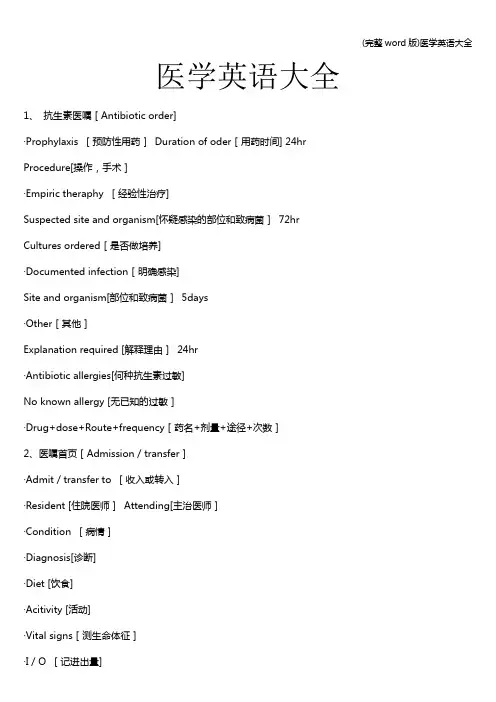
医学英语大全1、抗生素医嘱[Antibiotic order]·Prophylaxis [预防性用药]Duration of oder[用药时间] 24hr Procedure[操作,手术]·Empiric theraphy [经验性治疗]Suspected site and organism[怀疑感染的部位和致病菌]72hr Cultures ordered[是否做培养]·Documented infection[明确感染]Site and organism[部位和致病菌]5days·Other[其他]Explanation required [解释理由]24hr·Antibiotic allergies[何种抗生素过敏]No known allergy [无已知的过敏]·Drug+dose+Route+frequency[药名+剂量+途径+次数]2、医嘱首页[Admission / transfer]·Admit / transfer to [收入或转入]·Resident [住院医师]Attending[主治医师]·Condition [病情]·Diagnosis[诊断]·Diet [饮食]·Acitivity [活动]·Vital signs[测生命体征]·I / O [记进出量]·Allergies[过敏]3、住院病历[case history]·Identification [病人一般情况]Name[性名]Sex[性别]Age [年龄]Marriage[婚姻]Person to notify and phone No。
[联系人及电话]Race[民族]I.D.No。
[身份证]Admission date[入院日期]Source of history[病史提供者]Reliability of history[可靠程度]Medical record No[病历号]Business phone No.[工作单位电话]Home address and phone No.[家庭住地及电话]·Chief complaint[主诉]·History of present illness[现病史]·Past History[过去史]Surgical[外科]Medical[内科]Medications[用药]Allergies[过敏史]Social History[社会史]Habits[个人习惯]Smoking[吸烟]Family History[家族史]Ob/Gyn History[婚姻/生育史]Alcohol use[喝酒]·Review of Aystems[系统回顾]General[概况]Eyes,Ears,Nose and throat[五官] Pulmonary[呼吸]Cardiovascular[心血管]GI[消化]GU[生殖、泌尿系统]Musculoskeletal[肌肉骨骼]Neurology[神经系统]Endocrinology[内分泌系统]Lymphatic/Hematologic[淋巴系统/血液系统]·Physical Exam[体检]Vital Signs[生命体征]P[脉博]Bp[血压]R[呼吸]T[温度]Height[身高]Weight[体重]General[概况]HEENT[五官]Neck[颈部]Back/Chest[背部/胸部]Breast[乳房]Heart[心脏]Heart rate[心率]Heart rhythm[心律]Heart Border[心界]Murmur[杂音]Abdomen[腹部]Liver[肝]Spleen[脾]Rectal[直肠]Genitalia[生殖系统]Extremities[四肢]Neurology[神经系统]cranial nerves[颅神经]sensation[感觉]Motor[运动]*Special P.E。
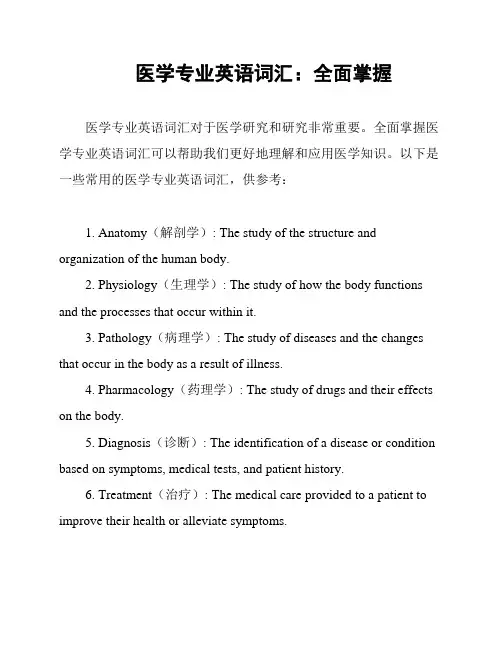
医学专业英语词汇:全面掌握医学专业英语词汇对于医学研究和研究非常重要。
全面掌握医学专业英语词汇可以帮助我们更好地理解和应用医学知识。
以下是一些常用的医学专业英语词汇,供参考:1. Anatomy(解剖学): The study of the structure and organization of the human body.2. Physiology(生理学): The study of how the body functions and the processes that occur within it.3. Pathology(病理学): The study of diseases and the changes that occur in the body as a result of illness.4. Pharmacology(药理学): The study of drugs and their effects on the body.5. Diagnosis(诊断): The identification of a disease or condition based on symptoms, medical tests, and patient history.6. Treatment(治疗): The medical care provided to a patient to improve their health or alleviate symptoms.7. Surgery(外科手术): The branch of medicine that involves using manual or instrumental techniques to treat diseases or injuries through operative procedures.8. Radiology(放射学): The use of medical imaging techniques, such as X-rays or MRI, to diagnose and treat diseases.9. Pediatrics(儿科学): The branch of medicine that focuses on the medical care of infants, children, and adolescents.10. Obstetrics and Gynecology(产科学和妇科学): The branch of medicine that deals with pregnancy, childbirth, and the female reproductive system.以上是一些医学专业英语词汇的简要介绍,希望对你的医学研究有所帮助。
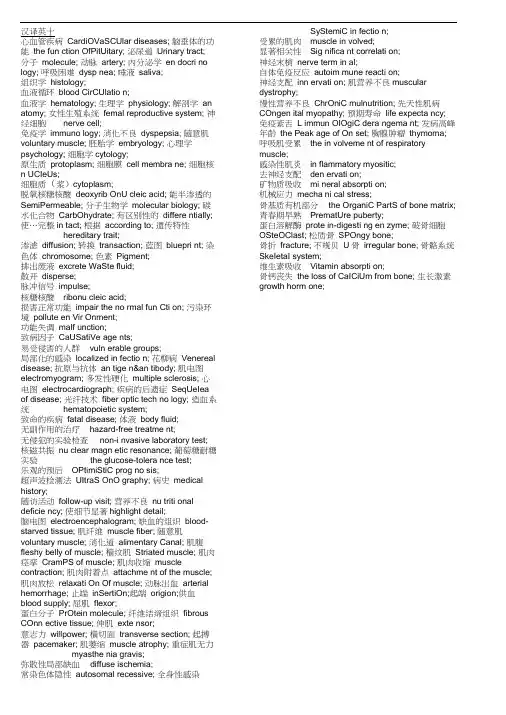
汉译英十心血管疾病CardiOVaSCUlar diseases; 脑垂体的功能the fun ction OfPitUitary; 泌尿道Urinary tract;分子molecule; 动脉artery; 内分泌学en docri no logy; 呼吸困难dysp nea; 唾液saliva;组织学histology;血液循环blood CirCUlatio n;血液学hematology; 生理学physiology; 解剖学an atomy; 女性生殖系统femal reproductive system; 神经细胞nerve cell;免疫学immuno logy; 消化不良dyspepsia; 随意肌voluntary muscle; 胚胎学embryology; 心理学psychology; 细胞学cytology;原生质protoplasm; 细胞膜cell membra ne; 细胞核n UCIeUs;细胞质(浆)cytoplasm;脱氧核糖核酸deoxyrib OnU cleic acid; 能半渗透的SemiPermeable; 分子生物学molecular biology; 碳水化合物CarbOhydrate; 有区别性的differe ntially; 使…完整in tact; 根据according to; 遗传特性hereditary trait;渗滤diffusion; 转换transaction; 蓝图bluepri nt; 染色体chromosome; 色素Pigment;排出废液excrete WaSte fluid;散开disperse;脉冲信号impulse;核糖核酸ribonu cleic acid;损害正常功能impair the no rmal fun Cti on; 污染环境pollute en Vir Onment;功能失调malf unction;致病因子CaUSatiVe age nts;易受侵害的人群vuln erable groups;局部化的感染localized in fectio n; 花柳病Venereal disease; 抗原与抗体an tige n&an tibody; 肌电图electromyogram; 多发性硬化multiple sclerosis; 心电图electrocardiograph; 疾病的后遗症SeqUeIea of disease; 光纤技术fiber optic tech no logy; 造血系统hematopoietic system;致命的疾病fatal disease; 体液body fluid;无副作用的治疗hazard-free treatme nt;无侵犯的实验检查non-i nvasive laboratory test; 核磁共振nu clear magn etic resonance; 葡萄糖耐糖实验the glucose-tolera nce test;乐观的预后OPtimiStiC prog no sis;超声波检测法UItraS OnO graphy; 病史medical history;随访活动follow-up visit; 营养不良nu triti onal deficie ncy; 使细节显著highlight detail;脑电图electroencephalogram; 缺血的组织blood-starved tissue; 肌纤维muscle fiber; 随意肌voluntary muscle; 消化道alimentary Canal; 肌腹fleshy belly of muscle; 横纹肌Striated muscle; 肌肉痉挛CramPS of muscle; 肌肉收缩muscle contraction; 肌肉附着点attachme nt of the muscle; 肌肉放松relaxati On Of muscle; 动脉出血arterial hemorrhage; 止端inSertiOn;起端origion;供血blood supply; 屈肌flexor;蛋白分子PrOtein molecule; 纤维结缔组织fibrous COnn ective tissue; 伸肌exte nsor;意志力willpower; 横切面transverse section; 起搏器pacemaker; 肌萎缩muscle atrophy; 重症肌无力myasthe nia gravis;SyStemiC in fectio n;受累的肌肉muscle in volved;显著相关性Sig nifica nt correlati on;神经末梢nerve term in al;自体免疫反应autoim mune reacti on;神经支配inn ervati on; 肌营养不良muscular dystrophy;慢性营养不良ChrOniC mulnutrition; 先天性肌病COngen ital myopathy; 预期寿命life expecta ncy;免疫紊舌L immun OIOgiC dera ngema nt; 发病高峰年龄the Peak age of On set; 胸腺肿瘤thymoma; 呼吸肌受累the in volveme nt of respiratory muscle;感染性肌炎in flammatory myositic;去神经支配den ervati on;矿物质吸收mi neral absorpti on;机械应力mecha ni cal stress;骨基质有机部分the OrganiC PartS of bone matrix; 青春期早熟PrematUre puberty;蛋白溶解酶prote in-digesti ng en zyme; 破骨细胞OSteOClast; 松质骨SPOngy bone;骨折fracture; 不规贝U骨irregular bone; 骨骼系统SkeIetaI system;维生素吸收Vitamin absorpti on;骨钙丧失the loss of CaICiUm from bone; 生长激素growth horm one;骺软骨epiphyseal cartilage;镁缺乏magnesium deficiency; 成骨细胞osteoblast; 密质骨compact bone; 骨髓腔marrow cavity; 红骨髓red marrow; 软骨内骨化endochondral ossification; 矫形学orthopedics; 闭合性骨折closed fracture;骨代谢疾病metabolic bone disease; 雌激素替代疗法estrogen replacement therapy; 肾上腺皮质adrenal cortex; 佝偻病rickets;骨肉瘤osteosarcoma;软骨肉瘤chondrosarcoma;止痛relieve pain; 类风湿关节炎rheumatoid arthritis; 骨髓炎osteomyelitis;开放性骨折open fracture;骨质疏松症osteoporosis; 营养缺乏nutritional deficiency; 骨软化症osteomalocia; 听力丧失hearing lose; 恶性肿瘤malignant tumor; 关节炎arthritis;抗炎剂anti-inflammatory drugs; 痛风gout;牙周组织periodontium;唾液腺salivary glands;口腔oral cavity; 升结肠ascending colon;贲门括约肌cardiac sphincter; 乳化作用emulsification; 消化道alimentary tract; 脾弯曲splenic flexure;锥形的突起cone-shaped papillae; 似袋状的器官pouch-like organ; 会厌epiglottis;十二指肠duodenum; 乙状结肠sigmoid colon;幽门括约肌pyloric sphincter; 舌下腺sublingual gland; 蠕动peristalsis;下颌下腺submandibular gland;解毒作用detoxification;回盲瓣ileocecal valve;胰岛素insulin; 穿孔perforation; 溃疡性结肠炎ulcerative colitis; 纤维变性fibrosis;阑尾炎appendicitis;胃十二指肠吻合术gastroduodenostomy; 直肠镜proctoscope; 裂孔疝hiatal hernia;造影剂contrast medium;代偿失调decompensation;胆石病choletithiasis; 内窥镜检查endoscopy;胆囊切除术cholecystectomy;憩室炎diverticulitis; 麻痹性肠梗阻paralytic ileus;胆绞痛biliary colic; 一个系列的 a spectrum of; 副鼻窦paranasal sinus; 口咽oropharynx; 脊椎动物verterbrate animal; 肺泡alveolus; 二氧化碳carbon dioxide; 肺换气不足hypoventilation; 横膈膜神经phrenic nerve; 双重折叠的double folded; 威慑物deterrent; 润滑液lubricating fluid; 滞痰stagnant sputum; 食管esophagus; 纵隔mediastinum; 哺乳动物mammal; 碱中毒alkalosis; 迷宫labyrinth; 污染物质pollutant; 脑干brainstem; 上皮,上皮细胞epithelium; 刺激物irritant; 利尿剂duretics; 大叶性肺炎lobar pneumonia; 疾病的鉴别differentiation of disease; 破坏性的损坏destructive damage; 痰性咳嗽productive cough; 共存coexist; 医学文献medical literatures; 咯血nemoptysis; 渗出物,渗出液exudate; 痰液phlegm; 气促,气短breathless; 无症状的asymptomatic; 吸烟者晨咳morning cigarette cough; 肺弹性回缩elastic recoil; 反复发作recurrent episodes; 有毒刺激物质nonxious agents; 连续三年successive 3 years; 交叉重复crossover; 互相排除的mutually exclusive; 小气道闭塞obliteration of small airway; 主动脉弓aortic arch; 胸主动脉thoracic aorta; 舒张压diastolic pressure; 腹主动脉abdominal aorta; 收缩压systolic pressure; 脊柱vertebral colum; 毫米汞柱mmHg; 半月形的semilunar; 最里层的innermost; 升主动脉ascending aorta; 二尖瓣bicuspid valve; 体循环systemic circuit; 上腔静脉superior vena cava 下腔静脉inferior vena cava; 心肌myocardium;心内膜endocadium; 细分;分支subdivision; 心外膜epicardium; 小动脉arteriole;心包pericardium; 全血细胞减少Pa ncytope nia; 网织红细胞reticulocyte; 自身免疫的autoim mune; 危及生命的Iife-threate ning; 凝结cougulation;血小板减少thrombocytopenia;免疫缺陷immuno deficie ncy;功能紊舌L dysf unction;活疫苗live VaCCi ne;移植物对宿主的反应graft-versus-host reactio n;血友病hemophilia;素质diathesis;巨成红细胞megaloblast;自发病特发病idiopathic;弥散性血管内凝血disseminated intravascularcoagulati on;内在的,内源性的inStrinsic;词汇分析1ape ndic/itis阑尾炎appe ndic∕o>appe ndix 2bil/i/rub in胆红素bil∕i>bile 3ch on dr/o/sarc/omaflesh 软骨肉瘤Chrondr/o >cartilage ; SarC/o >4chol/sterol胆固醇chol/e > bile, gall 5bucc/al口腔的;颊的bucc/o > bucca6cra ni/al颅的,颅侧的Cran i/o > skull 7co IOn/o/scope结肠镜colon/o > colon 8sigmoid/o/scope乙状结肠镜SigmOid/o > SigmOid colon 9in ter/cost/al肋间的cost/o > rib10de nt/in 牙质dent/o > teeth 11epi∕gastr∕ic胃上部的,腹上部的gastr/o > StOmaCh 12en ter/itis肠炎enter/o > small intestine 13arthr∕itis关节炎arthr/i > joint 14br on ch/o/ge nic支气管原的bron ch/o > bron ChUS 15cec∕um盲肠cec/o > CeCUm 16sub∕li ngu/al舌下的Iin gu/o > ton gue17g牙in giv/itis 艮炎gin giv/o > gum 18n as/o/gastr/ic鼻饲的gas/o > nose gastr/o > StOmaCh19hypo∕Phar yn g/eal下咽的Phary ng/o > Phary nx20diverticul∕osis憩室病diverticul/o > diverticulum21ile∕o∕stomy回肠造口术ile/o > ileum 22chol∕e∕cyst∕ectomy胆囊切除术chol/e > bile; CySt/o > SaC 23abdomi n/al abdomin/o > abdomen 腹部的24p neum On ∕ia Pneumon/o > IUng 肺炎25thorac∕ic thorac/o > PIeUraI CaVity ,chest CaVity 胸腔的26duode n/um deode n/o > duode num 十二指肠27lar yn g/o/phar ynx Iarygn/o > Iarynx Pharyng/o > Phary nx 咽喉28Vertebr/ate Vertebr/o > back bone 脊椎动物29oste∕o∕myel∕itis oste/o > bone;myel/o > bone marrow 骨髓炎30pa ncreat/ic胰腺炎Pan Creat∕o>pa ncreas 31a ngi∕o∕PIaSty an gio>vessels 血管成形术32extra∕o∕cular extra>outside 细胞外的33te ndon ∕ous ten>tendon 肌腱的34mamm∕o∕graphy mamm>breast 乳房X线检查术35electr∕o∕my∕o∕gram 肌电图electr>electricity,my>muscle36erythr∕o∕cyte红细胞eryth>red 37hem∕o∕glob in glob in> PrOtein 血红蛋白38prot∕o∕plasm prot>first 原生质39uri n/ary ary>pertaining to 泌尿道的40n eur/o/pathy neur>n erve 神经疾病41lymph∕atic lymph>lymph 淋巴的42my∕o∕fiber my>muscle 肌纤维43pelv∕ic pelv>pelvic bone 盆骨44hepat∕itis itis> in flammati on 肝炎45fibr∕ous fibr>fiber 纤维的46embry∕o∕logy embry>embryo 胚胎学47leuk∕emia emia>blood condition 白血病48electr∕o∕cardi∕o∕graph graph> in StrUme nt of record ing 心电图仪49dermat∕o∕my∕o∕sitis皮肤炎dermat>sk in 50thym∕ectomy ectomy>surgical exasiOn Or removal of 胸腺切除术51cyt∕o∕plasm cyt>cell 细胞浆52isch∕emia isch> to hold back 局部缺血53Steth∕o∕scope stech> the CheSt 听诊器54pul mon/ary PUl mon>lung 肺的55SarC∕o∕plasm plasm>formatiOn growth or SUbStance of formati on 肌浆56chrom∕o∕SOme some>body 染色体57VaSCUI∕ar VaSCUl>blood VeSSeI血管的病丿力翻译1•病人是一个被妈妈带来的5岁小男孩。
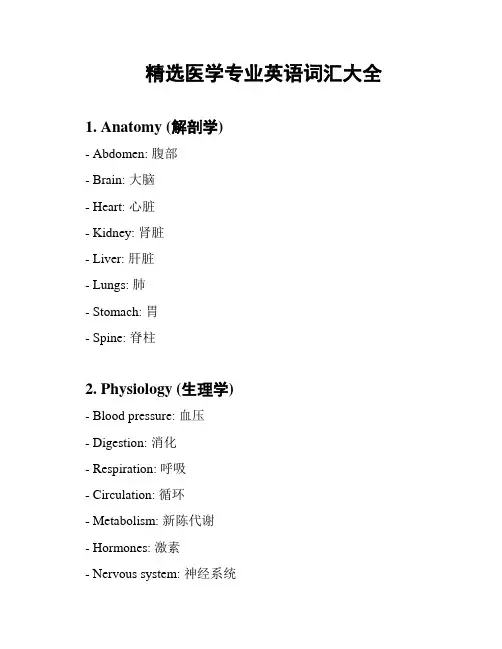
精选医学专业英语词汇大全1. Anatomy (解剖学)- Abdomen: 腹部- Brain: 大脑- Heart: 心脏- Kidney: 肾脏- Liver: 肝脏- Lungs: 肺- Stomach: 胃- Spine: 脊柱2. Physiology (生理学)- Blood pressure: 血压- Digestion: 消化- Respiration: 呼吸- Circulation: 循环- Metabolism: 新陈代谢- Hormones: 激素- Nervous system: 神经系统- Immune system: 免疫系统3. Diseases and Conditions (疾病与病况) - Diabetes: 糖尿病- Cancer: 癌症- Asthma: 哮喘- Hypertension: 高血压- Arthritis: 关节炎- Depression: 抑郁症- Obesity: 肥胖症- Pneumonia: 肺炎4. Medical Procedures (医疗程序)- Surgery: 手术- X-ray: X射线- MRI (Magnetic Resonance Imaging): 磁共振成像- Blood test: 血液检查- Vaccination: 疫苗接种- Dialysis: 透析- Chemotherapy: 化疗5. Medical Specialties (医学专科) - Cardiology: 心脏病学- Dermatology: 皮肤科- Gastroenterology: 胃肠病学- Neurology: 神经学- Psychiatry: 精神病学- Obstetrics and Gynecology: 妇产科- Orthopedics: 骨科- Pediatrics: 儿科6. Medical Instruments (医疗器械) - Stethoscope: 听诊器- Thermometer: 温度计- Sphygmomanometer: 血压计- Scalpel: 解剖刀- Syringe: 注射器- Electrocardiograph: 心电图仪- Ultrasound machine: 超声波机- Endoscope: 内窥镜以上是一份精选医学专业英语词汇大全,涵盖了解剖学、生理学、疾病与病况、医疗程序、医学专科和医疗器械等方面的词汇。
如对你有帮助,请购买下载打赏,谢谢!一、内科常用字汇心血管系统The Cardiovascular SystemAcute Myocardial Infarction (AMI) 急性心机梗塞Electrocardiogram (DCG) 心电图Hypertensive Cardiovascular Disease 高血压性心脏血管疾病Congential Heart Disease 先天性心脏病Hemangioma 血管瘤Vasodilatation 血管扩张Arteriosclerosis 动脉硬化Hypertension 高血压Hypertrophy 肥大Hypotension 低血压Varicose veins 静脉曲张血液及淋巴系统The Hemic and Lymphatic SystemAdenitis 腺炎Acute Lymphogenous Leukemia 急性淋巴球性白血病Leukocyte 白血球Leukocytopenia白血球减少Systemic Lupus Erythematosus 全身性红斑性狼疮Splenomegaly 脾肿大Anemia贫血Aseptic 无菌的Septicemia败血症Hemostasis 止血Transfusion输血呼吸系统The Respiratory SystemPulmonary embolism 肺栓塞Mucosa 黏膜Exhale呼吸Apnea窒息Tachypnea呼吸急促Pneumonia肺炎Bronchitis支气管炎Lung Empyema 肺积脓消化系统The Digestive System Short of breath 呼吸短促Dysphasia说话困难Aphasia 失语症Aphonia失声Dysphagia 吞咽困难Gingivitis 齿龈炎Pharyngitis 咽炎Laryngitis 喉炎Esophagoscopy 食道镜检查Esophagus stricture 食道狭窄Abdominocentesis腹部穿刺术Gastric cancer 胃癌Gastritis 胃炎Gastroenteritis胃肠炎Gastrorrhagia胃出血Pyloric obstruction 幽门阻塞Duodenal Ulcer 十二指肠溃疡Peritonitis 腹膜炎Enterorrhagia 肠出血Enterorrhexis 肠破裂Appendicitis 阑尾炎Colon cancer结肠癌Proctoscopy 直肠镜检查Rectal cancer 直肠癌Anal Fistual 肛门廔管External hemorrhoid 外痔Internal hemorrhoid 内痔Excretion 排泄Hepatitis肝炎Hepatomegaly 肝肿大Gall Stone 胆结石Cholelithiasis 胆石症Liver Cirrhosis 肝硬化Ascites腹水内分泌系统The Endocrine SystemGlycemia糖血症Goiter 甲状腺肿Diabetes Mellitus 糖尿病Diabetes Insipidus尿崩症Bromidrosis汗臭症Pituitary Tumor 脑下垂体肿瘤神经系统The Nervous System Cerebral Arteriosclerosis 脑动脉硬化Cerebral Hemorrhage 脑出血如对你有帮助,请购买下载打赏,谢谢!Cerebral Edema 脑水肿Cerebra Palsy脑性麻痹Cerebral Thrombosis 脑栓塞Cranial Neruritis 脑神经炎Intracranial Hemorrhage 颅内出血Encephalitis 脑炎Electromyography 肌电图Neuritis神经炎Epilepsy 癜痫Trigeminal Neuralgia 三叉神经痛Rachitis 痀偻症Rachioscoliiosis脊柱侧弯Spondylitis 脊椎炎Quadriplegia 四肢麻痹Paraplegia 下半身瘫痪Immediately loss of consciousness 立即丧失意识Eye opening睁眼反应Verbal response 语言反应Motor response 运动反应Corneal reflex 角膜反射Plantar reflex 膝反射Sciatica坐骨神经痛Chorea 舞蹈症Muscle atrophy 肌萎缩Migraine 偏头痛Parkinson's Disease 巴金森式症Brain Swelling 脑肿胀brain Concussion 脑震荡brain Anoxia脑缺氧症brain Death 脑死肌肉骨骼系统The Musculoskeletal SystemAnterior Cruciate Ligament 前十字韧带Rheumatoid Arthritis 类风湿性关节炎Arthrosclerosis关节硬化Degenerated Joint Disease变性关节炎Clavicle Fracture 锁骨骨折Pelvic Fracture 骨盆骨折Plastic Paris Cast 整形硬石膏Matastatic Lesion转移性损害Osteoporosis骨质疏松症Amputation 截肢Bone graft 骨移植Hallux Valgus大拇指外翻Prosthesis Replacement 人工弥补置换术Range of Motion 运动范围Varus 内翻Chondromalacia软骨软化症泌尿及男性生殖系统The Urinary and Male Reproductive SystemCystitis 膀胱炎Circumcision包皮环割术Cystoscopy 膀胱镜检查Hydronephrosis肾水肿Renal Stone 肾结石Acute Renal Failure 急性肾衰竭Cryptorchidism 隐睾症Spermatogenesis精子生成Benign Prostatic Hypertrophy 良性摄护腺肥大Ureteral stenosis 输尿管狭窄Dysuria 排尿困难Hematuria血尿Uremia尿毒症Urinary Tract Infection 尿路感染Vasoligation 输精管结扎Impotence 阳萎特殊感觉器官The Organs of Special SensesAudiometer 听力计Otitis耳炎Otorrhea耳漏Tympanitis中耳炎Tympanotomy 鼓膜穿破术Nasitis鼻炎Nasopharyngeal Carcinoma鼻咽癌Rhinorrhea 鼻溢Intraocular Foreign Body 眼内异物Intraocular pressure 眼内压Oculus Uterque 双眼Oculus Sinister 左眼Oculus Dexter 右眼如对你有帮助,请购买下载打赏,谢谢!Extraocular Muscle 眼外肌Ophthalmologist 眼科医师Diplopia 复视Myopia 近视Blepharoptosis 眼睑下垂Corneitis 角膜炎Pupil Size Anisocoria瞳孔大小不等Retinopexy 视网膜固定术Retinal Detachment 视网膜剥落Visual field 视野Vocal nodular 声带结节Dermatologist 皮肤科医师Dermatitis皮肤炎Cataract白内障Glaucoma青光眼综合性字汇Contraceptive避孕的Contraindication 禁忌症Biology 生物学Hyperemesis 剧吐Polydipsia剧渴Homosexual 同性的Heterosexual 异性的Inject 注射Lipoma 脂肪瘤Lipoid 脂肪样的Lipomatosis 脂肪过多症Malformaiton 畸形Malaise 不适Necrosis坏死Nocturia 夜尿症Ployuria 多尿Narcotics 麻醉药Hyperplasia 增殖Dysplasia 发育不良Dyspepsia 消化不良Prognosis 预後Antipyretic 解热剂Hydrophobia 恐水症Photophobia 畏光Antibiotic 抗生素Syndrome 症候群Hydrotherapy 水疗法Perforation 穿孔Percussion叩诊Visceralgia脏器痛二、妇产科常用字汇Genital 生殖的Gynecology 妇科Menstruation 月经Menopause 更年期Menorrhagia经血过多Amenorrhea 无月经Dysmenorrhea经痛Menarche初经Cervical cancer 子宫颈癌Cervical Erosion子宫颈糜烂Cervicitis子宫颈炎Perineum会阴Endometriosis子宫内膜异位Ovary 卵巢Ovarian Cyst 卵巢囊肿Ovulation排卵Vaginitis阴道炎Colposcopy 阴道镜检法Galactocele乳腺囊肿Mammography 乳房X光摄影术Infertility 不孕症InVitro Fertilization 体外受精Amnion 羊膜Amniocentesis 羊膜穿刺术Amniotic Fluid Embolism 羊水栓塞Hydramnion 羊水过多Anterpartal 产前的Antepartum 分娩前Chorionic Villi Sampling 绒毛膜绒毛取样Cephalo Pelvic Disproportion 胎头骨盆不对称Artificial Insemination 人工受精Engagement 进入产位Estrogen动情基素Colostrum 初乳Termination of Pregnancy 终止怀孕Corpus Luteum 黄体Vacuum Extraction Delivery 真空吸出分娩Venereal Disease 性病。
医学专业必备英语词汇医学专业必备英语词汇一:医学生物学Medical Biology医学遗传学Medical Genetics系统解剖学Systematic Anatomy组织学与胚胎学Histology and Embryology 人体生理学Human Physiology生物化学Biochemistry药理学Pharmacology病理生理学Pathophysiology病理学Pathology医学免疫学Medical Immunology医学微生物学Microbiology人体寄生虫学Human Parasitology流行病学Epidemiology卫生学Hygiene局部解剖学Regional Anatomy法医学Forensic Medicine实验诊断学Laboratory Diagnosis诊断学Diagnostics内科学Internal Medicine外科学Surgery妇产科学Obstetrics and Gynecology儿科学Pediatrics神经病学Neurology精神病学Psychiatry康复医学Rehabilitation Medicine中医学Chinese Traditional Medicine皮肤与性病学Dermatology and Venerology传染病学Infectious Diseases核医学Atomic Medicine口腔解剖生理学Oral Anatomy and Physiology 口腔组织病理学Oral Histology and Pathology 口腔粘膜病学Diseases of the Oral Mucosa牙体牙髓病学Cariology And Endodontics牙周病学Periodontics口腔正畸学Orthodontics口腔修复学Prosthodontics口腔颌面外科学Oral And Maxillofacial Surgery 口腔预防医学及儿童口腔医学PDPD麻醉解剖学Anesthesia Anatomy麻醉物理学Anaesthetic Physics临床麻醉学Clinical Anaesthesiology重症监护Intensive Care Therapy疼痛诊疗学Diagnosis and Treatment of Pain麻醉设备学Anesthesia Equipment医学影像学Medical Imaging影像物理学Physics of Medicine Imaging医学专业必备英语词汇二:生物药剂学与药物动力学Biopharmaceutics and Pharmacokinetics生药学Pharmacognosy天然药物化学Natural Medicine Chemistry药剂学Pharmaceutics药事管理学The Science of Pharmacy Administration护理学基础Fundamental Nursing儿科护理学Paediatric nursing内科护理学Medical Nursing外科护理学Surgical Nursing护理管理学Science of Nursing Management护理心理学Nursing Psychology急诊护理学Emergency Nursing医用物理学Medical Physics数学Mathematics体育Physical Education计算机Computer Science毛泽东思想概论Essentials of Mao Zedong Thought 邓小平理论Deng Xiao Ping Theory政治经济学Political Economy马克思主义哲学Marxism Philosophy法律基础Basis of Law医学伦理学Medicine Ethics医学心理学Medical Psychology市场营销Marketing会计学Accounting影像设备学Medical Imaging Equipment医用电子学Medical Electronics超声诊断Ultrasonic Diagnosis眼科学Ophthalmology基础眼科学Fundamental Ophthalmology临床眼科学Clinical Ophthalmology眼科手术学Ophthalmic Operative Surgery眼科诊断学Ophthalmologic Diagnostics耳鼻咽喉科学Otorhinolaryngology 无机化学Inorganic Chemistry有机化学Organic Chemistry分析化学Analytical Chemistry物理化学Physical Chemistry仪器分析Instrumental Analysis药物化学Medicinal Chemistry药物分析Pharmaceutical Analysis。
(word完整版)医学专业英语词汇一、内科常用字汇心血管系统The Cardiovascular SystemAcute Myocardial Infarction (AMI)急性心机梗塞Electrocardiogram (DCG)心电图Hypertensive Cardiovascular Disease 高血压性心脏血管疾病Congential Heart Disease 先天性心脏病Hemangioma 血管瘤Vasodilatation 血管扩张Arteriosclerosis 动脉硬化Hypertension 高血压Hypertrophy 肥大Hypotension 低血压Varicose veins 静脉曲张血液及淋巴系统The Hemic and Lymphatic System Adenitis 腺炎Acute Lymphogenous Leukemia 急性淋巴球性白血病Leukocyte 白血球Leukocytopenia白血球减少Systemic Lupus Erythematosus 全身性红斑性狼疮Splenomegaly 脾肿大Anemia贫血Aseptic 无菌的Septicemia败血症Hemostasis 止血Transfusion输血呼吸系统The Respiratory SystemPulmonary embolism 肺栓塞Mucosa 黏膜Exhale呼吸Apnea窒息Tachypnea呼吸急促Pneumonia肺炎Bronchitis支气管炎Lung Empyema 肺积脓消化系统The Digestive SystemShort of breath 呼吸短促Dysphasia说话困难Aphasia 失语症Aphonia失声Dysphagia 吞咽困难Gingivitis 齿龈炎Pharyngitis 咽炎Laryngitis 喉炎Esophagoscopy 食道镜检查Esophagus stricture 食道狭窄Abdominocentesis腹部穿刺术Gastric cancer 胃癌Gastritis 胃炎Gastroenteritis胃肠炎Gastrorrhagia胃出血Pyloric obstruction 幽门阻塞Duodenal Ulcer 十二指肠溃疡Peritonitis 腹膜炎Enterorrhagia 肠出血Enterorrhexis 肠破裂Appendicitis 阑尾炎Colon cancer结肠癌Proctoscopy 直肠镜检查Rectal cancer 直肠癌Anal Fistual 肛门廔管External hemorrhoid 外痔Internal hemorrhoid 内痔Excretion 排泄Hepatitis肝炎Hepatomegaly 肝肿大Gall Stone 胆结石Cholelithiasis 胆石症Liver Cirrhosis 肝硬化Ascites腹水内分泌系统The Endocrine System Glycemia糖血症Goiter 甲状腺肿Diabetes Mellitus 糖尿病Diabetes Insipidus尿崩症Bromidrosis汗臭症Pituitary Tumor 脑下垂体肿瘤神经系统The Nervous SystemCerebral Arteriosclerosis 脑动脉硬化Cerebral Hemorrhage 脑出血Cerebral Edema 脑水肿Cerebra Palsy脑性麻痹Cerebral Thrombosis 脑栓塞Cranial Neruritis 脑神经炎Intracranial Hemorrhage 颅内出血Encephalitis 脑炎Electromyography 肌电图Neuritis神经炎Epilepsy 癜痫Trigeminal Neuralgia 三叉神经痛Rachitis 痀偻症Rachioscoliiosis脊柱侧弯Spondylitis 脊椎炎Quadriplegia 四肢麻痹Paraplegia 下半身瘫痪Immediately loss of consciousness 立即丧失意识(word完整版)医学专业英语词汇Eye opening睁眼反应Verbal response 语言反应Motor response 运动反应Corneal reflex 角膜反射Plantar reflex 膝反射Sciatica坐骨神经痛Chorea 舞蹈症Muscle atrophy 肌萎缩Migraine 偏头痛Parkinson's Disease 巴金森式症Brain Swelling 脑肿胀brain Concussion 脑震荡brain Anoxia脑缺氧症brain Death 脑死肌肉骨骼系统The Musculoskeletal SystemAnterior Cruciate Ligament 前十字韧带Rheumatoid Arthritis 类风湿性关节炎Arthrosclerosis关节硬化Degenerated Joint Disease变性关节炎Clavicle Fracture 锁骨骨折Pelvic Fracture 骨盆骨折Plastic Paris Cast 整形硬石膏Matastatic Lesion转移性损害Osteoporosis骨质疏松症Amputation 截肢Bone graft 骨移植Hallux Valgus大拇指外翻Prosthesis Replacement 人工弥补置换术Range of Motion 运动范围Varus 内翻Chondromalacia软骨软化症泌尿及男性生殖系统The Urinary and Male Reproductive SystemCystitis 膀胱炎Circumcision包皮环割术Cystoscopy 膀胱镜检查Hydronephrosis肾水肿Renal Stone 肾结石Acute Renal Failure 急性肾衰竭Cryptorchidism 隐睾症Spermatogenesis精子生成Benign Prostatic Hypertrophy 良性摄护腺肥大Ureteral stenosis 输尿管狭窄Dysuria 排尿困难Hematuria血尿Uremia尿毒症Urinary Tract Infection 尿路感染Vasoligation 输精管结扎Impotence 阳萎特殊感觉器官The Organs of Special Senses Audiometer 听力计Otitis耳炎Otorrhea耳漏Tympanitis中耳炎Tympanotomy 鼓膜穿破术Nasitis鼻炎Nasopharyngeal Carcinoma鼻咽癌Rhinorrhea 鼻溢Intraocular Foreign Body 眼内异物Intraocular pressure 眼内压Oculus Uterque 双眼Oculus Sinister 左眼Oculus Dexter 右眼Extraocular Muscle 眼外肌Ophthalmologist 眼科医师Diplopia 复视Myopia 近视Blepharoptosis 眼睑下垂Corneitis 角膜炎Pupil Size Anisocoria瞳孔大小不等Retinopexy 视网膜固定术Retinal Detachment 视网膜剥落Visual field 视野Vocal nodular 声带结节Dermatologist 皮肤科医师Dermatitis皮肤炎Cataract白内障Glaucoma青光眼综合性字汇Contraceptive避孕的Contraindication 禁忌症Biology 生物学Hyperemesis 剧吐Polydipsia剧渴Homosexual 同性的Heterosexual 异性的Inject 注射Lipoma 脂肪瘤Lipoid 脂肪样的Lipomatosis 脂肪过多症Malformaiton 畸形Malaise 不适Necrosis坏死Nocturia 夜尿症Ployuria 多尿Narcotics 麻醉药(word完整版)医学专业英语词汇Hyperplasia 增殖Dysplasia 发育不良Dyspepsia 消化不良Prognosis 预後Antipyretic 解热剂Hydrophobia 恐水症Photophobia 畏光Antibiotic 抗生素Syndrome 症候群Hydrotherapy 水疗法Perforation 穿孔Percussion叩诊Visceralgia脏器痛二、妇产科常用字汇Genital 生殖的Gynecology 妇科Menstruation 月经Menopause 更年期Menorrhagia经血过多Amenorrhea 无月经Dysmenorrhea经痛Menarche初经Cervical cancer 子宫颈癌Cervical Erosion子宫颈糜烂Cervicitis子宫颈炎Perineum会阴Endometriosis子宫内膜异位Ovary 卵巢Ovarian Cyst 卵巢囊肿Ovulation排卵Vaginitis阴道炎Colposcopy 阴道镜检法Galactocele乳腺囊肿Mammography 乳房X光摄影术Infertility 不孕症InVitro Fertilization 体外受精Amnion 羊膜Amniocentesis 羊膜穿刺术Amniotic Fluid Embolism 羊水栓塞Hydramnion 羊水过多Anterpartal 产前的Antepartum 分娩前Chorionic Villi Sampling 绒毛膜绒毛取样Cephalo Pelvic Disproportion 胎头骨盆不对称Artificial Insemination 人工受精Engagement 进入产位Estrogen动情基素Colostrum 初乳Termination of Pregnancy 终止怀孕Corpus Luteum 黄体Vacuum Extraction Delivery 真空吸出分娩Venereal Disease 性病Tubal Ligation 输卵管结扎Laparoscope 腹腔镜Embryo 胚胎Ectopic Gestation 子宫外孕Primipara 初产妇Attitude of Fetus 胎儿体位Dead Detus in Uterus 胎死腹中Multipara 经产妇Parity 经产Placenta Previa前置胎盘Postpartum 产後Postpartum hemorrhage产後出血Toxemia of Pregnancy 妊娠毒血症Adolescence青春期Basal Body Temperature 基础体温Cesarean Section 剖腹产Expected Date of Confinement 预产期Fallopian Tube 输卵管Forceps 产钳Hydatidiform Mole 水囊状胎块Labor Pain阵痛Painless Labor 无痛分娩Molding胎头变形Normal Spontaneous Delivery 正常自然生产Papanicolaou Smear 子宫颈抹片检查Premature Rupture of Membrance 早期破水Progesterone黄体素Stillbrith死产Suture 缝合Stump残物Withdrawal Bleeding 停经出血三、小儿科常用字汇Apnea呼吸暂停Aplastic Anemia再生不良性贫血Arterio Venous Malformation 动静脉畸形Bronchial Asthma支气管性气喘Bronchitis支气管炎Cephalopematoma头血肿Erythema红斑Hypospadia尿道下裂Dehydration 脱水Hydrocephalus水脑Hydrocele 阴囊积水Polydactylia多指畸形(word完整版)医学专业英语词汇Pyoderma脓皮症Sepsis 败血症Tonsillitis扁桃腺炎Encephalitis脑炎Gastroenteritis肠胃炎Necrotizing Enterocolitis坏死性小肠结肠炎Malignant恶性的Congenital Malformation 先天性畸形Neonatal Asphyxia新生儿窒息Cleft Palate 颚裂Diarrhea腹泻Dental Caries 龋齿Facial Nerve Paralysis 颜面神经麻痹Hives Urticaria蕈麻疹Torticollis斜颈Vaccine疫苗Incubator 保温箱Cleft lip 兔唇Chicken pox 水痘Club foot 畸足Diphtheria白喉Dengue fever 登革热Eczema湿疹Congenital syphilis 先天性梅毒German Measles/ Rubella德国麻疹Giant baby巨婴Gonorrhea 淋病Hepatitis B B型肝炎Hand-foot—mouth disease 手足口病Jaundice 黄疸Mongolian spots 蒙古斑Mumps 腮腺炎Respiratory arrest呼吸停止Roseola infantum幼儿玫瑰疹Vomiting呕吐四、精神科常用字汇Mental retardation 智能不足autism自闭症dement 痴呆症alzheimer's dementia阿尔茲海默式形痴呆症alcoholism 酒瘾substances Intoxication 物质中毒alcohol Intoxication 酒精中毒amphetamine Intoxication 安非他命中毒schizophrenia精神分裂病delusional Disorder 妄想性病患Major Depressive Disorder重郁症疾患phobia畏惧症obsessive-Compulsive Disorder强迫性病患pedophilia恋童癖exhibitionism 暴露狂Transvestic Fetishism扮异性恋物癖Gender Identity Disorders 性别认同疾患Anorexia Nervosa心因性厌食症Bulimia Nervosa心因性暴食症临床症状blunted affect 感情迟钝silly Laughter 傻笑apathy冷漠irritable 易怒的euphoria欣快感depression 忧郁ambivalence感情矛盾Flat Affect感情平淡suicide attempt 自杀企图queer behavior 怪异行为bizarre behavior 特异行为hypertalkative 多话hypotalkative 少话mutistic不语hyperactivity 活动过多hypoactivity 活动过少compulsive behavior 强迫行为verbigeration 重复语言catelepsy 僵直negativism阻抗行动Mannerism作态行为destrctive behavior 破坏行为autistic thinking 自闭性思考poverty of speech 言语贫乏flight of ideas 意念飞跃loosening of association 思考连结松散illogical thinking 不合逻辑思考pressure speech 言语急迫thought blocking 思考中断incoherent 语无伦次thought Withdrawal 思想退缩irrelevant 答非所问delusion 妄想delusion of persecution 被害妄想delusion of grandeur 夸大妄想Phobia 恐惧症acrophobia 惧高症algophobia 惧痛症sexual drive 性欲illusion 错觉(word完整版)医学专业英语词汇hallucination 幻觉auditory hallucination 听幻觉disoreinatation 失去定向力amnesia记忆丧失症confabulation 虚谈症orientation 定向力judgement 判断力derealization 失真感insight病识感no insight 无病识感intellectual insight 理性的病识感true emotional insight 真正具有情绪性病识感心理学名词free association 自由联想dream analysis 梦的解析ego 自我id 原我super ego 超我ego boundary 自我界限libido 原欲scapegoat 代罪羔羊internal conflict 内在冲突conscious 意识unconscious 潜意识preconscious前意识transference 情感转移depersonalization 人格解体derealization 脱离现实neurosis神经精神病Psychosis神经病Pleasure Principle 享乐原则Reality Principle 现实原则Moral Principle 道德原则Predisposing Factors 潜在因素Precipitating Factors 诱发因素Defense Mechanism 防卫机转compensation 补偿作用conversion 转化作用denial 否认作用displacement 转移作用dissociation 解离作用fantasy 幻想作用identification 认同作用introjection 内射作用projection 外射作用retionalization 合理化作用reaction formation 反向作用degression 退化作用repression 潜抑作用suppression 压抑作用restitution 归还作用sublimation 升华作用substitution 取代作用symbolism 象徵作用undoing 抵销作用distortion 曲解作用isolation 隔离作用Cognitive behavioral Therapy认知行为治疗Empathy 同理心Resistance阻抗testing out behavior 试探行为self—awareness自我了解separation anxiety 分离焦虑reinforcement 增强原则catharsis 情绪宣泄confrontation 面质listen 倾听restraint 约束physical restraint 身体的约束chemical 药物的约束五、各科常用缩写AAAD against-advice discharge 自动出院A abdomen 腹部ADL activities of daily life 日常生活活动A/G albumin /globulin ration 白蛋白/蛋球白比例AK above knee 膝上B。
(完整word版)基础医学英语词汇常见医学单词:BSL Blood Sugar Level 血糖水平anti-coagulation 抗凝CHF Congestive Heart Failure 充血性心力衰竭constrict / constriction 收缩RBC Red Blood Celldilate / dilation 舒张WBC White Blood Cellnegative 阴性Platelet 血小板positive 阳性Plasma/serum 血浆myocardium 心肌Consciousness 意识coronary artery 冠状动脉Hypoxia 缺氧ventricle 心室Osmotic pressure 渗透压atrium 心房Colloid Osmotic pressure 胶体渗透压blood supply 血供Spinal column 脊柱BT bleeding time 出血时间Acidosis 酸中毒Alkalosis 碱中毒CT clotting time 凝血时间Pulmonary edema 肺水肿water-soluble 水溶性nerve 神经fat-soluble 脂溶性Oxygen 氧气pulmonary arterial / vein肺动/静脉Carbon dioxide 二氧化碳elastic 有弹性的Stomach 胃tissue 组织Gastric contents 胃内容物aorta 主动脉Risk factor 危险因素exchange 交换Flushed skin 皮肤发红gallbladder 胆囊Pallor 苍白lung 肺Dizziness 头晕kidney 肾Nausea 恶心cardiac output 心输出量V omit 呕吐peripheral resistance 外周阻力Seizure 惊厥systolic blood pressure 收缩压Enema 灌肠diastolic blood pressure 舒张压Electrolyte 电解质normal range 正常范围Fluid and electrolyte imbalance 水电解质紊乱capillary 毛细血管BUN blood urea nitrogen血尿素氮circulatory system 循环系统Blood gas 血气release 释放Hormone 激素superficial 表浅的Protein 蛋白质blood volume 血容量Albumin 白蛋白bradycardia 心动过缓Glucose 葡萄糖tachycardia 心动过速Hemoglobin 血红蛋白valve 瓣膜Sternum 胸骨forearm 前臂Rib 肋骨breast 胸部,乳房Liver 肝armpit 腋窝Spleen 脾groin 腹股沟Pancreas 胰腺prevent 预防Iron 鉄bloodstream 血流Calcium 钙fiber 纤维Magnesium 镁acute 急性的Sodium 钠diarrhea 腹泻Potassium 钾Antibody-antigen complex 抗原抗体复合物Bone marrow 骨髓myocardial infarctionTransplant 移植low-grade fever 低热Blurred vision 视力模糊chill 寒战Spontaneous 自主的urticaria 风疹Dysrhythmia 心律不齐inhibitor 抑制剂GI irritation 胃肠刺激inflammation 炎症Intake and output 出入量angioplasty 血管扩张术Hypokalemia 低血钾normal saline 生理盐水Hyperkalemia 高血钾circulatory overload 循环负担过重Hypotension 低血压shortness of breath 气短Hypertension 高血压restless 烦躁不安Antihypertensive 抗高血压药rapid and thready pulse 脉搏细速Headache 头痛orthopnea 端坐呼吸Urinary retention 尿储留pallor/ cyanosis 苍白Angina pectoris 心绞痛chest paincentral venous pressure 中心静脉压Sublingual 舌下的Fowler’s position 端座卧位Oral 口服的Semi- Fowler’s position 半座卧位Topical 局部的dyspnea 呼吸困难Calcium channel blocker 钙离子通道阻滞剂diuretics 利尿剂Mucosa 粘膜impaired 受损的Orthostatic hypotension 体位性低血压pink and frothy sputum粉红色泡沫样痰Hypoglycemia 低血糖yellow sputum 黄痰Hyperglycemia 高血糖blood-streaked sputum 血丝痰Hypovolemia 低血容量mucoid sputum 黏液痰Hypervolemia 高血容量breathing pattern 呼吸模式Preload and afterload (心脏的)前后负荷sterile 无菌的Dehydration 脱水container 容器Uric acid 尿酸cool clammy skin 皮肤湿冷Sign 体征preventive 预防性的Symptom 症状bronchitis 支气管炎Symptom free/ asymptomatic 无症状pneumonia 肺炎Monitor 监测concentration 浓度Constipation 便秘barrel chest 桶状胸Skin rash 皮疹distended neck vein 颈静脉怒张Heparin 肝素external irritant 外界刺激物Warfarin 华法林endocrine system 内分泌系统Hemorrhage 大出血insulin 胰岛素Therapy 疗法absorption 吸收Alcohol 酒精reabsorption 再吸收Anemia 贫血shock 休克Folic acid 叶酸trauma 外伤Allergic reaction 过敏反应complication 并发症Bile 胆汁compensatory 代偿的Bile acid 胆汁酸Cholesterol 胆固醇Obesity 肥胖症Stuffy nose 鼻塞collect sputum and blood specimen for culture and sensitivity tests 收集痰血标本做细菌培养和药敏COPD chronic obstructive pulmonary disease 慢性阻塞性肺疾病DM Diabetes Mellitus 糖尿病Gestational diabetes 妊娠糖尿病Ketone body 酮体Ketoacidosis 酮症酸中毒Insulin resistant 胰岛素耐受Carbohydrate 碳水化合物Mechanism 机制,机理IDDM (Type 1) insulin-dependant diabetes mellitue 胰岛素依赖性糖尿病NIDDM (Type 2) non-insulin-dependant diabetes mellitue非胰岛素依赖性糖尿病Glucose Tolerance Test 糖耐量试验Oral anti-diabetic medications 口服降糖药PVD peripheral vascular disease 外周血管病Arterioatherosclerosis 动脉粥样硬化CAD coronary artery disease 冠心病CVD cerebral vascular disease 脑血管病Polyuria 多尿Ulcer 溃疡Gangrene 坏疽Fatigue 疲乏Blurred vision 视力模糊Fasting blood sugar 空腹血糖2-hour post-prandial glucose 餐后两小时血糖Hemoglobin 血红蛋白Metabolic acidosis 代谢性酸中毒Respiratory acidosis 呼吸性酸中毒Ketonuria 酮尿Sweet breath odor 烂苹果味呼吸Mental confusion 精神错乱Slurred speech 说话含糊不清Wound healing 伤口愈合Renal function 肾功能Renal failure 肾衰Uremia 尿毒症Creatinine 肌酐Urea 尿素Internal 内部的External 外部的Itching 痒BUN blood urea nitrogen 血尿素氮Carbon dioxide combining power 二氧化碳结合力Urine gravity 尿比重Bleeding tendency 出血倾向Injury 外伤Patency 开放,通畅Bed sore 褥疮Skin care 皮肤护理Paraplegia 截瘫Pacemaker 起搏器Elevate 抬高Pitting edema 凹陷型水肿Sodium-restricted diet 限钠饮食Interstitial space 组织间隙Extremity 四肢,肢端Deficiency 缺乏,不足Blood transfusion 输血GI irritation 胃肠刺激Pleural space 胸膜腔Fluctuate 波动Kink 弯曲,折住Water-seal chamber 水封瓶Subcutaneous emphysema 皮下气肿Airtight 密封的Sharp pain 锐痛Dull pain 钝痛Burning pain 灼痛Radiating pain 放射痛各科室名称:medical department; department of internal medicine: 内科surgical department; department of surgery: 外科department of obstetrics and gynecology : 妇产科ophtalmology department: 眼科dental department: 牙科ENT(ear-nose-throat)department: 耳鼻喉科urology department: 泌尿科dermatology department; skin department: 皮肤科orthopedic surgery department: 矫形外科traumatology department: 创伤外科plastic surgery: 整形外科anesthesiology department: 麻醉科pathology department: 病理科cardiology department: 心脏病科psychiatry department: 精神病科orthopedics department: 骨科department of cardiac surgery: 心脏外科department of cerebral surgery: 胸外科neurology department: 神经科neurosurgery department: 神经外科thoracic surgery department: 脑外科department of traditional Chinese medicine: 中医科registration office: 挂号处out-patient department: 门诊部in-patient department: 住院部nursing department: 护理部consulting room: 诊室waiting room: 候诊室emergency room: 急诊室admitting office: 住院处operation room: 手术室X-ray department: 放射科blood bank: 血库dispensary; pharmacy: 药房ward: 病房laboratory: 化验室牤Department of Nephrology 肾内科Department of Chemotherapy 化疗科Department of Radiotherapy 放疗科Department of Endocrinology 内分泌科Respiratory medicine 呼吸科Rheumatology 风湿科Hematology 血液科Geriatrics 老年科Neurology 神经科Oncology 肿瘤科Thoracic surgery 胸外科Urology 泌尿外科Neurosurgery 神经外科Vascular surgery 周围血管外科Gastroenterology 肠胃外科Hepatobiliary surgery 肝胆外科General surgery 普外科Orthopedics 骨科Cardiovascular surgery 心外科Burns surgery 烧伤科Hand surgery 手外科Plastic surgery 整形外科Pediatric surgery 儿外科Obstetrics and gynecology 妇产科Stomatology 口腔科Ophthalmology 眼科Infectious disease 感染科Dermatology 皮肤科Otorhinolaryngology (ENT) 耳鼻喉科Nuclear medicine 核医学科Psychiatry 精神科Medical rehabilitation 康复科Anesthesiology 麻醉科Radiology 放射科Ultrasonography 超声科Pain management 疼痛科Pharmacology 药理科Internal Medicine 内科常见护理英语80句一.Receiving the patient(接待病人)1.How do you do? / Good morning!您好!(初次见面时使用)/早上好!2.What can I do for you? /Can I help you?您需要我帮助吗?3.I’ll bring you to your bedside, plea se follow me. This is your bed..我要领您到床边去.请跟我来.这是您的床位.4.The toilet is over there. 卫生间在那边5.We supply hot water. 我们供应热水6.Please wait a moment. I’ll let your doctor know. / I’ll inform your doctor.请等一会儿,我去通知医生.7.Mary is the nurse /doctor in charge of you.玛丽是您的负责护士/医生8.Please let us know if you need any help. 您需要帮助时,请告诉我们.9.Smoking is not allowed here.这里不允许吸烟二.information collection (收集信息)10.Do you mind if I ask you a few questions? 您介意我问您几个问题吗?11. We need some information from you. 我们需要从您这儿收集一些信息.12. Is your tummy still sore? 您的肚子还疼吗?13. Does your pain come on after or before meals? 您的疼痛是在饭前还是饭后发作?14. Does it hurt to pass urine? /when I press here? 排尿时痛吗?/ 当我按压这儿时痛吗?15. Does your back ache? 您的后背痛吗?16.Do your feet swell?您的脚肿了吗?17. Do you have a cough/fever? 您咳嗽吗?/ 您有发热吗?18. Do you bring up any sputum? 您咳痰吗?19. Is there any radiation of the pain? (to the shoulder)有放射(到肩部的)痛吗?20. How long have you had the pain? 您的痛有多长时间了?21. When did the pain start? /where is your pain? 疼痛从什么时候开始的/什么地方疼痛?22. Are your periods regular? 您的月经规则吗?三.Physical examination(查体)23.Will you please undress for medical examination? 请您脱下衣服做体检好吗?24. Take off your clothes, please. 请把衣服脱下来25.Lie down on the couch, please. /Just lie still on the couch and relax.请躺在治疗床上./ 请安静地躺在治疗床上,放松.26.Bend your knees, please. 请屈膝.27.Open your mouth and say ’ah" 张开口, 说: 啊28.Beathe deeply, please./take a deep breath, please.请深呼吸29.May I examine your tummy, please? 我要检查下您的肚子,好吗?30.Roll up your sleeves, please. 请卷起袖子.四.Communication. (交流)31.I am going to take your temperature./Please put the thermometer under your armpit.我要测一下您的体温/请把体温计放在您的腋下.32.Let me feel your pulse.让我测一下您的脉搏.33. I’ll test/take your blood pre ssure. 我要测量您的血压.34. I’m af raid I have to prick your finger and take a drop of blood for blood sugar level.我要取一滴指血做血糖测定, 需要刺一下手指.35. I’ll take some blood from your arm now. 现在我要从您的胳膊抽血.36. Don’t take any thing by mouth after midnight until the blood is drawn tomorrow morning.半夜之后不要吃喝任何东西,明天早上抽血.37. Please bring a specimen of your urine/stool/sputum./ please collect your mid-stream specimen of urine.请留一份尿/便/痰的标本/请收集您的中段尿.38. Please have your blood and urine tests done. 请做一下您的血和尿试验.39. You are going to have a CT-scan of your chest/head today.今天您要做一个胸部/头部CT.40. You are going to have a chest X-ray this morning. 今天早上您要拍一个胸片.41. You are going to have a B-mode ultrasonic exam. Please keep your bladder full.您要做B超检查,请留尿,使膀胱充盈.42. You are going to have an gastric endos copy tomorrow morning. Please don’t eat or drink anything after 12 o’clocktonight. 明天上午您要做胃镜检查,今晚12点之后,请不要吃喝任何东西。
医学常用英语1000单词总结第一单元:1. odd 临时的、不固定的(1) He did odd jobs around the house during his holiday.(2) The boy doing enough odd jobs to stay in grass and food(3)She kept herself alive working at odd jobs until she landeda position managing advertising accounts for a local magazine.2. Natural:非常适合或肯定成功的人(事物)(1) People think I am a natural for the sort of television work required of me, but I have had work at it.(2) She's a natural for the role of Snow Wheingite.(3)She didn't have to learn how to run: she's a natural.3. Board:寄宿,寄膳,为.....提供膳宿(动词)(1) The boy once said ,”My father and I only board here”.(2)During my stay in England I boarded with a family in Bath until I found a place of my own.(3) He boarded at my house/with me until he found a flat4. Workaholic:工作狂(名词)(1)Phil’s wife feels bitter about him being an utter workaholic–he cares about noting but his work.5. Replacement:替换的人或物(名词)(1)They asked Barbara, who was about to resign, to stay on until theycould find a suitable replacement for her.(2)The company president had begun to make inquiries about hisreplacement.6. straighten out:向-讲清楚,把-弄清楚,整顿,清理、处理、解决(1)His business affairs are in a terrible mess, they’ll takeages to straighten out.(2)She would need him to straighten out the finances-the stock points and all that.(3)We have several financial problems that need to be straightened out right away.7. look…in the eye:坦然地正视某人(1)Since he broke the neighbour’s windows, the boy can’t look his father in the eye.(2)The widow didn’t look him in the eye.8. ask around:四处打听(1)Our babysitter’s just moved away, so we are asking around for a replacement.(2)He asked around:”who’s been working the hardest.”9. and all that:诸如此类(1)Being a shopaholic, she went around a lot searching for fancy dresses, luxury accessories, and all that.(2)She would need him to straighten out the finances-the stock points and all that.(3)When you go away for the holiday, be sure to turn off the gas, the water, the electricity and all that.(4)They were forced to sell their house, clothes and all that.(5)Coffee, tea and all that will be served in the garden........................................................................................................................ ....................................... 第二单元:1.stain :玷污,污染,留下难以清除的痕迹(v)(1)He hoped the blood from the cut on his arm would not stain his whiteshirt which was prepared for his interview.(2)Poverty is getting up every morning from a dirt- and illness-stainedmattress.(3)Tomato sauce stains terribly - it's really difficult to get it out ofclothes.(4)While she was changing the wheel on her car, her coat had becomestained with oil.2.spoil :变质,变坏(vi)(1)This is a smell of urine, sour milk, and spoiling food sometimes joinedwith the strong smell of long-cooked onions.(2)The milk has spoilt3.sore :痛的,疼痛的,肌肉酸痛的(形容词)(1) After days of hard work without rest, the corners of her mouthbecame cracked and sore.(2) I have to decide every day if I can bear to put my cracked sore hands into the cold water and strong soap.(3)All the dust has made my eyes sore.(4)I've got a sore throat.(5)My feet were sore with all the walking4. devour :吞食狼吞虎咽的吃光(动词)(1) The boys devoured their pancakes.(2) The young cubs hungrily devoured the deer that the lion had killed.(3) In summer, poverty is watching gnats and flies devour your baby’s tears when he cries.(4) After the exhausting tennis match Wendell devoured the sandwiches in seconds, the licked his fingers greedily.5.spill :溢出,流出(v)(1)I spilt coffee on my silk shirt(2)Let's see if I can pour the juice into the glass without spilling it.(3)Crowds of football fans spilled onto the field at the end of the game.(4) After spilling the whole shame of your poverty all over the desk between you, you find that this is n’t the right office after all.6. turn to :求助于,求教于(1)Don't hesitate to turn to us if you are in difficulty.(2)I tried to stand on my own two feet rather than turned to my parents.(3)They turn to the religion for consolation.(4) They will turn to other boys who steal to get what they want./doc/f2cd34ad240c844768eaee23.html e off :脱落(1) The label had come off so there was no way of knowing what was on disk.(2) When the dried diaper came off, bits of my baby’s flesh came with it.(3) A button on your coat has come off.8. wear away :磨灭磨损,磨掉(1) Feeling physically weak or out of shape usually wears away/eats away your sense of personal competence.(2)The steps had been worn away by the feet of thousands of tourists.(3)Constant dripping wears away a stone.(4)Poverty is an acid that drips on pride until all pride is worn away.9. put oneself in sb.’s shoes :站在别人的立场上(1)Supposing you put yourself in his shoes, would you have behaved differently in the circumstances?10. wear out :穿破(1) Horses used for long-distance riding tend to wear their shoes out more quickly.(2) Put yourself in my dirty, worn out, ill-fitting shoes, and hear me. 11. eat away :侵蚀,消耗,逐渐毁掉(1)There is no denying that rapid population growth itself eats away at the development potential of a country.(2)The acid in the rain slowly ate away the iron gate.(3)Gambling was eating away his savings.(4)She has Alzheimer’s disease, which is eating aw ay her mind.12. at best:在最好的情况下(1)All the staff opposed the technique- it is ineffective at best and at worst dangerous.(2)At best, there is for her a life like mine.第三单元1.preach:布道,讲道(动词)(1)Every night for weeks there had been much preaching, singing,praying, and shouting, and some very hardened sinners.(2)She preached to the congregation about forgiveness.(3)He devoted his life to preaching the word of God2.hardened:变硬的,坚定的,坚定、变硬(1)The metal in the mould hardened into shape.(2)Attitudes to the territory disputes have hardened on both sides.3.escort:护送、护卫(动词)(1)Having finished their inspection, the officers were escorted by armedguards to waiting helicopter.(2)Several little boats escorted the sailing ship into the harbor.(3)The police escorted her to the airport, and made sure that she left thecountry.(4)That night I was escorted to the front of row and placed on themourner’s bench with the other young sinners.4.swirl:旋转,打旋,旋动(动词)(1)He lost his footing on the bridge, fell into the water and was swirledaway by the current.(2)She smiled, swirling the wine in her glass.(3) Swirl a little oil around the frying pan.(4)The river had become a swirling torrent.(5)He breathes out a swirl of cigarette smoke.(6)Sundae swirl ice cream(7)My aunt came and knelt at my knees and cried, while prayers andsongs swirled all around me in the little church.5.wail:号啕声(名词)(1)The women gathered around the coffin in a mighty wail, as was thecustom in the region.(2)The child wailed as he cut his finger.(3) The breath went out of her in a wail, her body shook with violentsobbing.(4) I heard the wail of a police siren.(5)The whole congregation prayed for me alone, in a mighty wail ofmoans and voices.6.grin:露齿而笑; 咧着嘴笑; 龇着牙笑(动词)(1)On hearing the news, he appeared serious for a moment and thenbegan to grin and finally laughed out loud.(2)He grinned at me, as if sharing a secret joke.(3)He was grinning like an idiot.(4)He came into the room with a friendly grin on his face.7.deceive:欺骗, 蒙蔽(动词)(1)I was deceived by his uniform-I really thought he was a police officer.(2)That I had deceived everybody in the church.(3)His friendly manner deceived us.(4)He tried to deceive the public into thinking the war could still be won.(5)I was deceived into thinking that he was trustworthy.8.rejoice:庆祝,欢庆(rejoicing名词)(1)There was much rejoicing when the two miners were rescued afterbeing trapped in relics for 19 days.(2) There was much rejoicing at/over the good news(3)Waves of rejoicing swept the Place.(4)Everyone rejoiced at/over the news of his safe return.(5) She rejoiced in her good fortune.(6) I rejoiced to see that she had made such a quick recovery.(7) They rejoiced that the civil war was over.9.punctuate:不时打断(动词)(常于with连用,一般用被动语态)(1)As she was preparing dinner in the kitchen, Carol heard their intimiateconversation punctuated every now and then by bursts of laughter.(2)He punctuated his remarks with pounding on the table.(3)The announcement was punctuated by cheers from the crowd.(4)When things quieted down, in a hushed silence, punctuated by a fewecstatic ”Amens”.10.h old up:推迟,耽搁(常用被动语态)(1)The peace talks between the two countries have been held up bycontinued fighting on the border.(2)Sorry I'm late - I was held up at work.(3)Continuing violence could hold up progress towards reform.(4)I began to be ashamed of myself, holding everything up so long. 11.b y leaps and bounds:非常迅速的,突飞猛进的。
文档来源为 :从网络收集整理.word 版本可编辑 .欢迎下载支持 .医学专业英语的重点单词终结版Human Body1.anatomy(解剖学 )31.hip joints ( 髂关节 )61.urethra(尿道)2.embryology( 胚胎学 )32.cushioning (缓冲)62.bile( 胆汁 )3.histology( 组织学 )33.striated muscles(条纹肌)63.gallbladder ( 胆囊 )4.hematology( 血液学 )34.smooth muscles(平滑肌)64.sodium (钠)5.immunology( 免疫学 )35.voluntary muscles( 随意肌 )65.potassium( 钾)6.biology( 生物学 )36.function ( 功能 )66.bladder(膀胱)7.cytology( 细胞学 )37.nourishment (营养)67.pancreas(胰腺)8.physiology( 生理学 )38.nutrient (营养素)68.hormone (激素)9.endocrinology (内分泌学)39.blood vessel(血管)69.pituitary( 脑垂体 )10.psychology( 心理学 )40.cardiovascular system ( 心血管系统 )70.thyroid( 甲状腺 )11.skeletal system(骨骼系统 )41.artery(动脉)71.adrenal gland ( 肾上腺 )12.muscular system (肌肉系统 )42.capillary (毛细血管)72.cortisone( 可的松 )13.circulatory system ( 循环系统 )43.vein (静脉)73.adrenaline(肾上腺素 )14.respiratory system( 呼吸系统 )44.lymphatic system (淋巴系统)74.insulin (胰岛素)15.urinary system ( 泌尿系统 )45.lymph vessel ( 淋巴管 )75.glucagon( 胰高血糖素 )16. endocrine system(内分泌系统 )46.lymph nodes( 淋巴结 )76.collar bone (锁骨)17.reproductive system( 生殖系统 )47.spleen(脾)77.spinal column( 脊柱 )18.principal ( 重要的 )48.expel(排除)78.spinal cord (脊髓)19.joint( 关节 )49.carbon dioxide( 二氧化碳 )79.sperm(精子 )20.cartilage(软骨 )50.oxygen (氧气)80.ovum (卵子)21.bone marrow (骨髓)rynx , throat (喉管)81.testis, testes 睾丸 )(22.cube-shaped(立方的 )52.windpipe 、 trachea(气管 )82.ovary(卵巢)23.interior (内部的)53.esophagus(食管 )83.testosterone (睾酮 )24.external (外部的 )54.exhale(呼出)84.progesterone(孕酮)25.hinge joint( 结合点 )55.molecule (分子)85.estrogen(雌激素)26.pivot joint ( 区轴点 )56.saliva( 唾液 )86.tactile (触觉的)27.socket (臼槽 )57.enzyme(酶)87.accessory (附属的 )28.skull ( 颅骨 )58.kidney (肾)88.pharynx( 咽 )29.elbow ( 肘部 )59.urine (尿液)30.breast(胸部)60.ureter(输尿管)Human disease1.pathology ( 病理学 )18.epidemic disease(传染病)35.typhoid fever (伤寒)2.pathogen(病原体)19.endemic disease(地方病)36.boils (疥)3.fungi( 真菌 ) fungus(s.)20.airborne droplets (空气传播的)37.pimples(小脓包 )4.bacteria(细菌 ) bacterium(s.)21.apnea(呼吸暂停)38.pus(脓)5.virus( 病毒 ) viruses(pl.)22.atonia(张力缺乏)39.abscess(脓肿)6.diagnose(诊断)23.degeneration(退化)40.armpit (腋窝)7.paralysis(瘫痪 , 麻痹)24.Stomatitis (口腔炎)41.blood poisoning/sepsis( 败血症 )8.symptom (症状)25.prolapse(直肠、子宫等脱垂脱出)42.phagocyte(吞噬细胞)9.sign(体征)26.malfunction (功能失调)43.antigen(抗原)10.symptomatic (有症状的)27.obesity (肥胖)44.antibody (抗体)11.asymptomatic (无症状的)28.malnutrition (营养不良的)45.immunoglobulin( 免疫球蛋白 )12.acute disease(急性病)29.hereditary(遗传)46.opsonization (调理作用)13.chronic disease(慢性病)30.mental retardation( 智力发育迟缓的 )plement(补体)14.subacute disease(亚急性病)31.venereal disease(花柳病)48.negative feedback control (负反15.fatal(致命的)32.hepatitis(肝炎)馈调节)16.rheumatic fever (风湿热 )33.colitis (结肠炎)17.subarachnoid(蛛网膜下的)34.cholera(霍乱)The Digestive System1.gastrointestinal tract ( 胃肠道 ) 3.absorption (吸收) 5.elimination( 排泄 )2.ingestion(摄入 ) 4.digestive( 消化 ) 6.oral cavity/buccal cavity (口腔)7.palate(腭 )27sublingual gland ( 舌下腺 )47.appendix(阑尾 )8.chewing(mastication) (咀嚼)28.epiglottis( 会厌 )48.stool/feces(粪便)9.swallowing(deglutition) (吞咽)29.nasal cavity( 鼻腔 )49.anus(肛门)10.incisor (切牙)30.peristalsis(蠕动 )50. hydrochloric acid ( 盐酸 )11.cuspid(尖牙) canine(犬牙)31.fundus( 胃底 )51.abdomen(腹部 )12.molar( 磨牙 )32.antrum(胃窦)52.cholesterol (胆固醇)13.cementum(牙骨质 )33.cardiac sphincter( 贲门括约肌 )53.bile pigment( 胆色素 )14..gum(牙龈 )34.pyloric sphincter( 幽门括约肌 )54.bilirubin( 胆红素 )15..gingiva( 牙龈 )35.chyme( 食糜 )55.blood protein( 血红蛋白 )16.pulp( 牙髓 )36.duodenum( 十二指肠 )56.erythrocyte (红细胞)17.enamel(牙釉质 )37.jejunum( 空肠)57.glycogen( 糖原 )18.periodontium( 牙周组织 )38.ileum (回肠)58.cilia 、 villi (绒毛)19.deciduous dentiton( 乳牙 )39.cecum(盲肠 )59.amylase(淀粉酶 )20.permanent dentition ( 恒牙 )40.rectum(直肠)60.lipase(脂肪酶 )21.lower jaw bone (下颌骨)41.colon( 结肠 )61.hepatic duct(肝管 )22.papillae(乳头 )42.sigmoid colon ( 乙状结肠 )62.cystic duct( 胆囊管 )23.taste bud(味蕾)43.ileocecal valve ( 回盲瓣 )mon bile duct (胆总管)24.uvula(悬雍垂 )44.ascending colon ( 升结肠 )64.detoxification (解毒)25.parotid gland( 腮腺 )45.transverse colon (横结肠 )65.emulsification ( 乳化作用 )26.submandibular gland( 下颌下腺 )46.descending colon ( 降结肠 )66.bile acid ( 胆酸 )1.gingivitis ( 牙龈炎 )2.peptic ulcer (消化性溃疡)3.vomiting (呕吐)4.perforation( 穿孔 )5.barium( 钡 )6.hiatal( 裂孔的 )7.hernia(疝 )8.endoscopy (内窥镜检查 )9.hemorrhage(出血 )10.histamine ( 组胺 )11.chest cavity (胸腔)12.diaphragm(膈)13.gastritis(胃炎)14.hepatitis(肝炎)15.cirrhosis( 肝硬化 )16.hepatomegaly(肝肿大 )17.edema(浮肿 )18.jaundice(黄疸 )1.pulmonary veins (肺静脉)2.irritant( 刺激物 )3.frontal sinus (额窦)4.ethmoidal sinus (刷窦)5.sphenoid sinus(蝶窦)6.maxillary sinus(上颌窦)7.paranasal sinus(副鼻窦 )8.nasal cavity(鼻腔)9.nostril( 鼻孔 )10.nasopharynx (鼻咽)11.oropharynx(口咽)12.hypopharynx (下咽)ryngopharynx (喉咽)14.adenoids(腺体肿大)The Disorders of the Digestive System19.architecture( 结构 )37.peritonitis( 腹腔炎 )20.nodule(结节 )38.ulcerative colitis( 溃烂性结肠炎 )21.micronodular( 小结节 )39.antibiotic( 抗生素 )22.macronodular( 巨结节 )40.fistula( 瘘 )23.lobular( 小叶的 )41.diverticulum (憩室)24.cholelithiasis( 胆结石 )42.diverticulitis( 憩室炎 )25.cholecystitis( 胆囊炎 )43.diverticulosis( 憩室病 )26.biliary colic (胆绞痛)44.polyps (息肉)27.nausea (恶心 )45.diarrhea(腹泻 )28.cholecystectomy( 胆囊切除术 )46.occult blood( 隐血 )paroscope(腹腔镜 )47.proctoscope(直肠镜 )30.pancreatitis(胰腺炎 )48.sigmoidoscope( 乙状结肠镜 )31.paralytic ileus( 麻痹性肠梗阻 )49.colonoscope(结肠镜 )32.autodigestion( 自体消化 )50.ileostomy( 回肠造口术 )33.necrosis(坏死 )51.colostomy (结肠造口术)34.epigastric( 腹上部的 )52.gastroduodenostomy(胃十二指肠吻35.appendicitis( 阑尾炎 )合术 )36.navel(脐)53.coloproctostomy (结肠直肠吻合术)Respiratory System15.hypopharyngeal(下咽的)29.oblique fissure (斜裂)16.pharyngeal tonsils (咽扁桃体)30.apex(肺尖)17. palatine tonsils (腭扁桃体)31.hilum (肺门)18.tongue tonsil (舌扁桃体)32.Collarbone (锁骨)19.vocal cords(声带)33.diaphragm(横膈 )20.mucous membrane(分泌粘液的膜 )34.mediastinum (纵隔)21.fibrous connective tissue( 纤维结缔组织 )35.thoracic cavity (胸腔)22.bronchi (支气管)36.abdominal cavity (腹腔)23.Bronchiole (细支气管)37.inhalation/inspiration( 吸气 )24.alveoli , alveolus (肺泡)38.exhalation/expiration (呼气)25.epithelium (上皮)39.brainstem(脑干 )26.parietal pleura (壁层胸膜)40.phrenic nerve(膈神经)27.visceral pleura (脏层胸膜)41.acid(酸 )28.horizontal fissure (水平裂)42.acidity (酸度)43.acidosis(酸中毒 )46.alkalosis (碱中毒)49..macrophages(巨噬细胞)44.alkalinity (碱度)47.hyperventilation (换气过度)50.mucus(粘液)45.alkali( 碱 )48.hypoventilation (换气不足)Respiratory Disorders and Diseases1.pneumonia(肺炎 )16.consolidation( 实变 )30.pneumothorax( 气胸 )2.tuberculosis( 结核 )17.dyspnea(呼吸困难 )31.pneumoconiosis( 尘肺 )3.asthma (哮喘 )18.cyanosis(紫绀 )32.silicosis( 矽肺 )4.allergic( 过敏的 )19.wheeze(喘息 )33.anthracosilicosis( 碳矽末沉着症 )5.emphysema(肺气肿 )20.Steroids(类固醇 )34.bronchitis( 支气管炎 )6.influenza( 流行性感冒 )21.allergen( 过敏原 )35.bronchiectasis(支气管扩张)7.pneumonitis( 肺炎 )22.polio( 脊髓灰质炎 ,小儿麻痹症 )36.bronchospasm(支气管痉挛)8.lobar pneumonia( 大叶性肺炎 )23.paralyze(瘫痪 )37.hypercapnia(高碳酸血症)9.bronchopneumonia( 支气管肺炎 )24.mature(成熟的 )38.simple chronic bronchitis( 单纯10.pleurisy( 胸膜炎 )25.prematurely( 过早地 , 早熟地 )性慢性支气管炎 ).11.tubercle(结核结节 )26.digitalis( 洋地黄 )39.chronic obstructive bronchitis12.hemoptysis(咯血 )27.diuretics( 利尿剂 )(慢性梗阻性支气管炎 )13.phlegm( 痰 )28.atrium( 心房 )40.asthmatic bronchitis( 哮喘性支14.exudates(渗出物 )29. acute pulmonary edema(急性肺气管炎 )15.solidification( 固化 )水肿)41.noxious (有害的,有毒的)Common disorders of the cardiovascular1.atherosclerosis(动脉粥样硬化 )17.glomerulonephritis( 肾小球肾炎 )33.dextran(右旋糖酐 )2.lumen(内腔)18.pyelonephritis( 肾盂肾炎 )34.vomitus (呕吐物)3.ischemia(局部缺血)19.rheumatic heart disease(风湿性心脏病 )35.spermatic cord ( 精索 )4.coronary heart disease(冠心病 )20.valvular murmur( 瓣膜杂音 )36.ligament( 韧带 )5.angina pectoris(心绞痛)21.systolic pressure(收缩压 )37.uterus(子宫)6.clot(血凝块)22.diastolic pressure(舒张压)38.piles,hemorrhoid( 痔疮 )7.thrombosis(血栓形成 )23.congestive heart failure (充血性心力衰竭)39.varix,varices( 静脉曲张 )8.thrombus(血栓 )24.vegetation ( 赘生物 )40.phlebitis (静脉炎)9.myocardial infarction( 心肌梗死 )25.essential hypertension(原发性高血压)41.etiology( 病因学 )10.arhythmia( 心律不齐 )26.secondary hypertension(继发性高血压)42.dextran(右旋糖酐 )11.fibrillation( 纤维性颤动 )27.endocarditis(心内膜炎)12.embolism( 栓塞 )28.pericardial tamponade( 心包填塞 )13.embolus(栓子 )29.pericarditis( 心包炎 )14.stroke(中风)30.hemorrhage(出血)15.subcutaneous(皮下的 )31.shock(休克)16.syncope(晕厥 )32.plasma(血浆)Blood and immunity1.hemocyte(血细胞 )17.electrolyte( 电解质 )33.phagocyte(吞噬细胞 )2.erythrocyte( 红细胞 )18.clotting factors( 凝血因子 )34.phagocytosis( 吞噬作用 )3.leukocyte( 白细胞 )19.nucleus(核) nuclei(pl.)35.megakaryocyte( 巨核细胞 )4.platelets(血小板 )20.erythropoietin( 促红细胞生成素 )36.hemostasis(止血 )5.thrombocytes(血小板 )21.granulocytes( 粒细胞 )37.immunoglobulin( 免疫球蛋白 )6.clotting cells( 血小板 )22.eosinophil( 嗜酸性粒细胞 )38.thymus gland( 胸腺 )7.plasma(血浆 )23.basophil( 嗜碱性粒细胞 )39.lymphoid organs( 淋巴器官 )8.fibrinogen( 纤维蛋白原 )24.neutrophil( 嗜中性粒细胞 )40.debris(残片 )9.fibrin( 纤维蛋白 )25.agranulocyte( 无粒细胞 )41.cytotoxic (细胞毒性)10.albumin( 白蛋白 )26.monocyte( 单核细胞 )42.interferons( 干扰素 )11.globulin( 球蛋白 )27.lymphocyte( 淋巴细胞 )43.interleukins( 白细胞介素 )12.prothrombin( 纤维蛋白原 )28.polymorphonuclear( 多形核细胞 )44.anemia(贫血 )13.globin( 珠蛋白 )29. detoxify( 解毒作用 )45.fatigue (乏力)14.hemoglobin (血红球蛋白)30.heparin(肝素)46.heart palpitation( 心悸 )15.pigment (色素)31.phagocytic ( 吞噬细胞的 )47.pallor( 面色苍白 )16.heme(亚铁血红素)32.macrophages(巨噬细胞 )48.irritation (烦躁不安)49.aplastic anemia(再生障碍性贫血)64.purpura(紫癜 )77.plasma cells (浆细胞 )50.pancytopenia(全细胞减少 )65.hemophilia( 血友病 )78.osteolytic( 溶骨性的 )51.hemolytic anemia ( 溶血性贫血 )66.intramuscular( 肌肉下的 )79.myeloblast( 成髓细胞,原粒细胞 )52.spherocytosis(球形红细胞增多症)67.autoimmune disease80.lymphoblast( 成淋巴细胞 )53.jaundice(黄疸 )(自身免疫性疾病 )81.hypercalcemia( 高钙血症 )54.pernicious( 恶性贫血 )68.hematuria(血尿 )82.itching( 痒 )55.megaloblast(巨成红细胞 )69.hemarthrosis(关节积血 )83.rash(皮疹)56.sickle cell anemia( 镰刀细胞性贫70.leukemia( 白血病 )84.sneezing(喷嚏 )血)71.neoplasms(肿瘤 )85.urticaria (荨麻疹)57.arthralgias(关节痛 )72.acute myelogenous leukemia( 急86.asthma(哮喘)58.extremities( 四肢 )粒)87.immunodeficiency( 免疫缺陷 )59.ulceration( 溃疡 )73.acute lymphocytic leukemia ( 急淋 )88.dysgammaglobulinemia( 异常γ球蛋60.thalassemia(地中海贫血 )74.chronic myelogenous leukemia白血症 )61.thrombocytopenia( 血小板减少症 )(慢粒 )89.extrinsic( 外缘的 )62.petechiae(瘀点 )75.chronic lymphocytic leukemia90.intrinsic (内源性的)(慢淋 )63.ecchymosis(瘀斑 )91.lymphadenopathy ( 淋巴结病 )76.multiple myeloma (骨髓瘤)Development & Genetics1.zygote(合子 )16.oxytocin (催产素)31.amnion( 羊膜囊 )2.oviduct( 输卵管 )17.prostaglandin (前列腺素)32.menstrual(月经)3.endometrium( 子宫内膜 )18. meiosis(减数分裂,成熟分裂)33.birth canal( 产道 )4.embryo(胚胎 )19.mitosis (有丝分裂)34.gravida (孕次)5.chorionic sac( 绒毛囊 )20.triplet (三胞胎)35.primigravida (初孕妇)6.chorion(绒毛膜)21.quadruplet( 四胞胎 )36.para(产次)7.gonadotropin (促性腺激素)22.dissimilar (不同的)37.inheritable (可遗传的)8.corpus luteum(黄体 )23.abort(流产)38.offspring (后代)9.placenta(胎盘)24.vagina( 阴道 )39.dominant (显性)10.amniotic sac(羊膜囊)25.cervix (子宫颈)40.recessive(隐性)11.amniorrhea(破水)26.fallopian tubes( 输卵管)41.cell division (细胞分裂)12.trimester(三个月,三月期)27.fertilization( 受孕,受精 )42.rearrangement(重排)13.parturition (分娩)28.pregnancy tests(妊娠试验)43.fragment(碎片)14.dystocia (难产)29.fetus( 胎儿 )44.dissimilar (不同)15.cesarean birth(剖宫产)30.umbilical cord (脐带 )45.identical (相同)Disorders of Pregnancy & Genetic Disease1.preeclampsia/eclampsia(先兆子痫 )16.measles(麻疹 )31.incur( 招致 )2.toxemia( 毒血症 )17.herpes simplex(单纯疱疹 )32.mutagen(诱变剂,诱变因素 )3.proteinuria( 蛋白尿 )18.syphilis( 梅毒 )33.mutagenic( 诱变的 )4.ectopic(异位的 )19.atresia(闭锁畸形 )34.carcinogen( 致癌物 )5.salpingitis( 输卵管炎 )20.anencephalus(无脑畸形 )35.albinism( 白化病 )6.endometriosis(子宫内膜异位症 )21.spina bifida( 脊柱裂 )36.pigmentation( 色素沉着 )paroscopic(腹腔镜检查的 )22.cleft lip( 唇裂 )37.homozygote(纯合子 )8.miscarriage(自然流产 )23.cleft palate( 腭裂 )38.progeny(后裔,后代 )9.incompetence(无能力 )24.diabetes mellitus( 糖尿病 )39.schizophrenia( 精神分裂症 )10.induced abortion ( 人工流产 )25.amniocentesis(羊膜穿刺术 )40.counselor(咨询者;顾问 )11.suction( 抽吸 )26.karyotype( 染色体组型 )41.mutant(突变型;变异的 )12.birth defect( 先天缺陷 )27.chorionic villus( 绒膜绒毛 )42.prenatal(出生前的 )13.teratogen(致胎儿畸形药 )28.transmit( 传递 )43.lethal( 致命的 )14.malformation( 畸形;变形 )29.Mendelian fashion( 孟德尔遗传定律) 44.euphenics(优型学 )15.rubella/german measles(风疹 )30.immunogenetics( 免疫遗传学 )45.euphenic(优型学的 )Endocrine System1.endocrine(内分泌 ) 5.glandular (腺体的)9.target tissue(靶组织)2.dwarf (矮小症) 6.reproduction (生殖)10.receptor(受体)3.hormone(激素)7.metabolism (代谢)11.hormonal (激素的)4.gland(腺体)8.nutrien (营养素)12.steroid(类固醇)13.lipid (脂)14.protein(蛋白)15.proteinlike compound(似蛋白的化合物)16.gonad(性腺)17.cortex(皮,皮)18.adrenal gland (上腺)19.kidney ()20.renin (素)21.calcium ()22.phosphorus(磷 )23.pituitary (垂体)24.thyroid (甲状腺)25.parathyroid (甲状旁腺)26.pancreas(胰)27.pineal(松果体)28.sphenoid(蝶骨)29.anterior lobe (前叶)30.adenohypophysis(腺垂体)31.posterior lobe(后叶)32. neurohypophysis (神垂体)33.hypothalamus (下丘)34.mammary(乳房的)35.antidiuretic (抗利尿的)36.oxytocin (催素)文档来源 :从网收集整理.word 版本可 .迎下支持 .37.uterine(子的)61. Parathyroid hormone ( PTH)38.isthmus(峡)62. calcitonin (降血素)39.thyroxine (T4)63.Cushing's syndrome (欣合症)40.triiodothyronine ( T3)64.primary aldosteronism( 原性固41.calcitonin (降素)增多症 )42.homeostasis(内)65.pheochromocytoma (嗜胞瘤)43.medullar (髓的)66.gigantism (巨人症)44.corticosteroid (皮固醇)67.acromegaly (肢端肥大症)45.glucocorticoid (糖皮激素)68.diabetes insipidus (尿崩症)46.cortisol (可的松)69.hyperthyroidism(甲状腺功能亢症)47.mineralocorticoid (皮激素)70.Graves'disease48.aldosterone(固)71.hyperparathyroidism (甲状旁腺功能49.epinephrine (上腺素 )亢)50.norepinephrine ,noradrenaline(去72.hypoparathyroidism(甲状旁腺功能低甲上腺素)下)51.abdomen(腹部)73.hyperglycemia (高血糖)52.exocrine(外分泌的)74.Addison's disease53.islets of Langerhans (胰)75.diabetes mellitus (糖尿病)54.ovarian (卵巢的)76.glucose(葡萄糖)77.ketoacidosis(酸中毒)55.estradiol(雌二醇)56.progesterone(孕)78.endemic goiter( 地方性甲状腺大 )79.nodular goiter (性甲状腺大)57.pregnancy(孕)58.malatonin (褪黑素)80.myxedema(粘液性水)81.bruit (音)59.puberty(青春期)60.circadian rhythms (昼夜律)82.ptosis(上下垂)The Nervous System1.neuron(神元 )17.gray matter( 灰 )30.fissure(裂)2.neurology( 神病学 )18.neurotransmitter( 神 )31.sulcus(沟 )3.acetylcholine (乙胆碱)19.neuroglia (神胶)32.thalamus(丘 )4.efferent(出神 )20.astrocyte(星型胶胞)33.hypothalamus( 下丘 )5.afferent(入神 )21.glioma (神胶瘤)34.diencephalon()6.parasympathetic(副交感神 )22.microglia( 小神胶胞 )35.pons()7.sympathetic(交感神)23.oligodendroglia(少突胶胞)36.cerebellum( 小 )8.ganglion( 神 )24.cerebrum( 大 )37.brain stem( 干 )9.plexus(神 )25.convolution , gyrus(回 )38.medulla oblongata( 延髓 )10.dendrite(突 )26.peripheral nervous system( 周39.meninx (膜)11.electrical charge(信号 )神系 )40.cauda epuina (尾 )12.axon(突 )27.autonomic nervous system( 自主41.dura(硬膜 )13.myelin( 髓鞘 )神系 )42.mater(脊髓膜)14.neurilemma( 神鞘 )28.visceral nervous system(内神43.arachnoid(蛛网膜 )15.synapse(突触)系)44.pia mater( 脊膜 )16.white matter (白)29.groove( 沟 )45.lumbar puncture( 腰椎穿刺 ) 8床英卷子(蔡江瑜整理)Tips:介于市面上缺少英真,是我根据整理的,漏了几个,段落翻只能得些关,不翻翻是能找到的,大家一些参考。